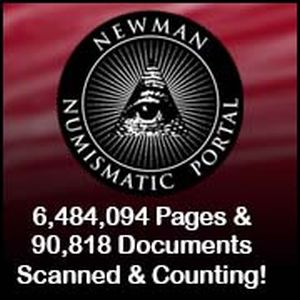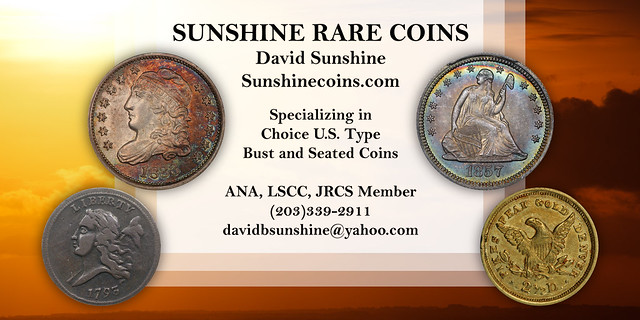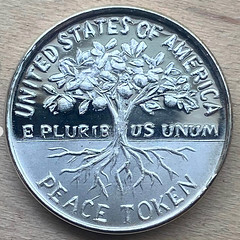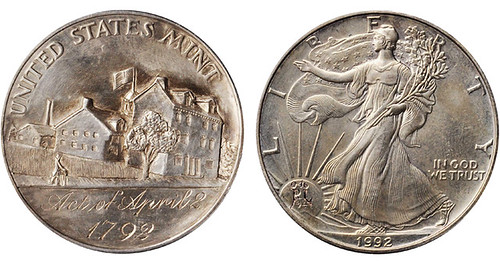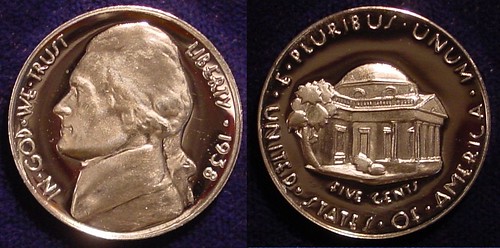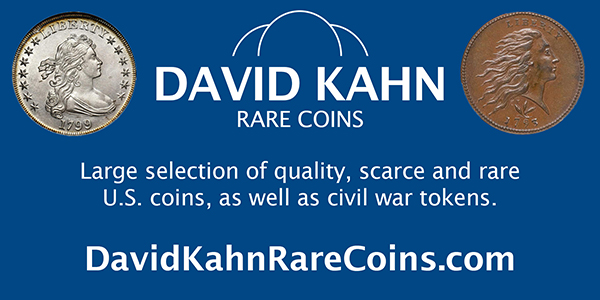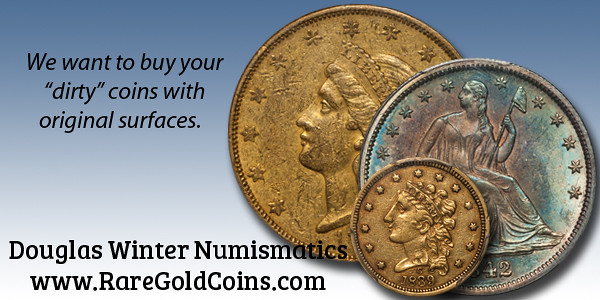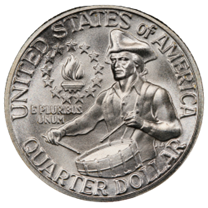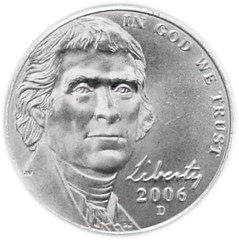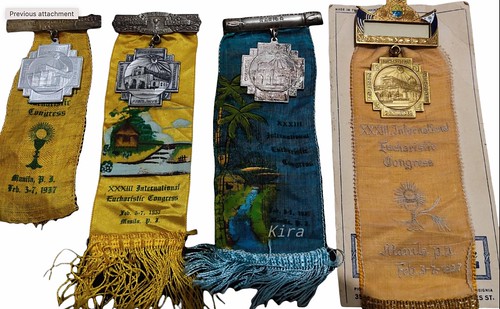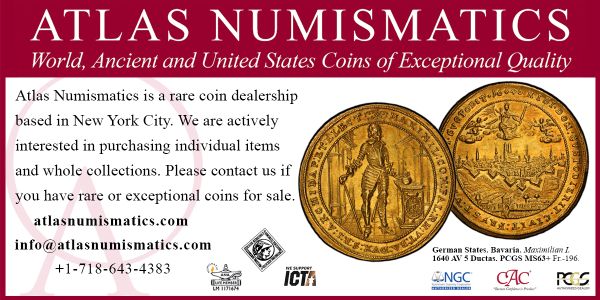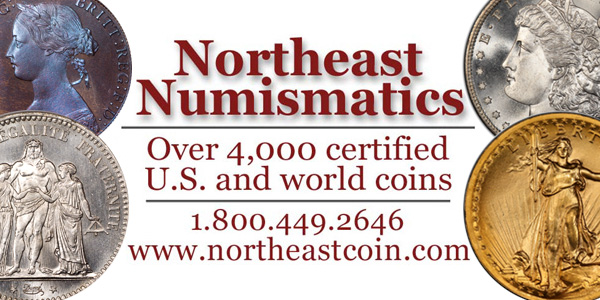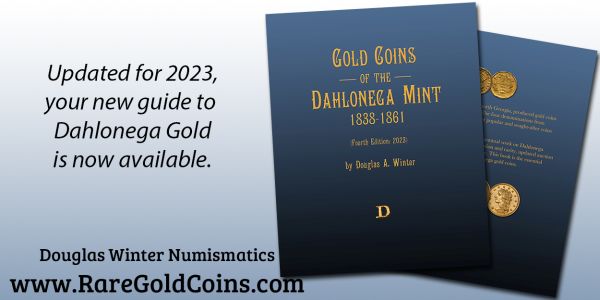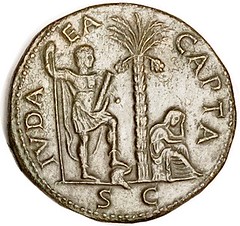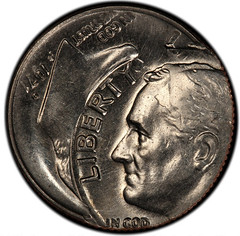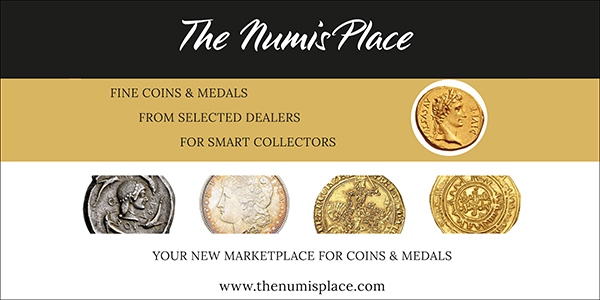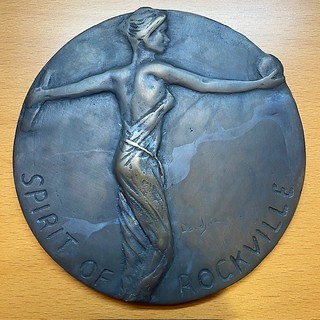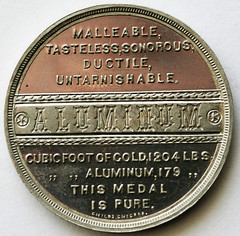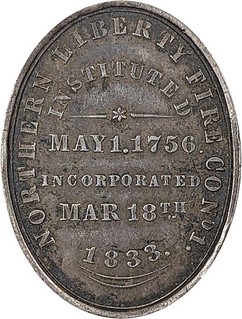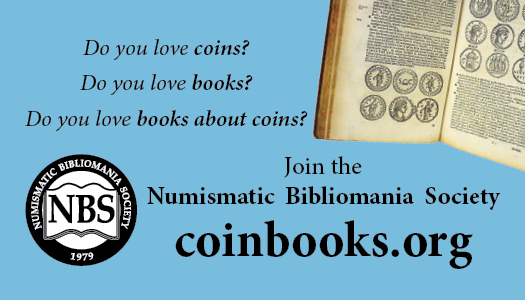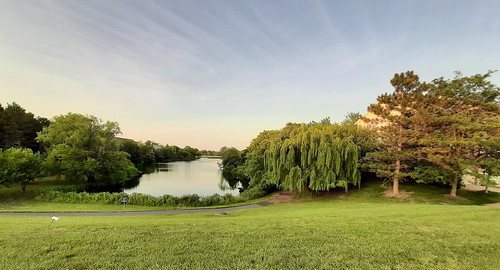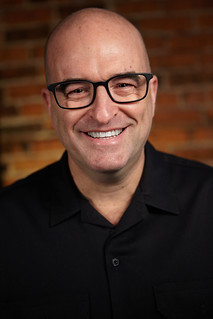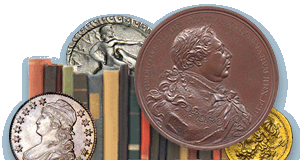
Visit our NBS Sponsors
About UsThe Numismatic Bibliomania Society is a non-profit association devoted to the study and enjoyment of numismatic literature. For more information please see our web site at coinbooks.org SubscriptionsThose wishing to become new E-Sylum subscribers (or wishing to Unsubscribe) can go to the following web page link MembershipThere is a membership application available on the web site Membership Application To join, print the application and return it with your check to the address printed on the application. Print/Digital membership is $40 to addresses in the U.S., and $60 elsewhere. A digital-only membership is available for $25. For those without web access, write to: Jeff Dickerson, Treasurer AsylumFor Asylum mailing address changes and other membership questions, contact Jeff at this email address: treasurer@coinbooks.org SubmissionsTo submit items for publication in The E-Sylum, write to the Editor at this address: whomren@gmail.com BUY THE BOOK BEFORE THE COINSale Calendar
|
- WAYNE'S WORDS: THE E-SYLUM JUNE 22, 2025
- NEW BOOK: BETTS MEDALS COMPANION (1747-1763)
- NEW BOOK: NORWEGIAN BANKNOTES
- JOHN WAYNE HIGHFILL (1943-2025)
- RONALD WAYNE LANDIS (1954-2025)
- THE THREE C4S
- VIDEO: AMERICA'S STATE QUARTERS
- MORE ON SOPHIA HOLMES
- NOTES FROM E-SYLUM READERS: JUNE 22, 2025
- THE COIN MAKEOVER AMERICA NEEDS
- VOCABULARY TERM: RIBBON
- EDNESS KIMBALL WILKINS (1896-1980)
- NUMISMATIC TREASURES AT OKLAHOMA ANA
- PHILIPPINE COLLECTORS FORUM AT OKLAHOMA ANA
- NUMISMAGRAM MEDAL SELECTIONS: JUNE 22, 2025
- ANCIENT COINS IN ROBINSON AUCTION 128
- HERITAGE JUNE 2025 U.S. ERROR COINS
- WAYNE'S NUMISMATIC DIARY: JUNE 22, 2025
- THE COINS OF SARDINIA
- DENMARK LETS AMATEURS DIG FOR TREASURE
- LOOSE CHANGE: JUNE 22, 2025
- FEATURED WEBSITE: NUMISMATICS INTERNATIONAL
- ABOUT THIS ISSUE: JUNE 22, 2025
Content presented in The E-Sylum is not necessarily researched or independently fact-checked, and views expressed do not necessarily represent those of the Numismatic Bibliomania Society.
WAYNE'S WORDS: THE E-SYLUM JUNE 22, 2025
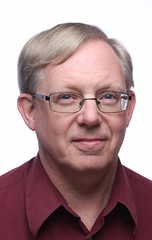 New subscribers this week include:
1715 Fleet Society members Michael Brown, Robert Kasicki and others, courtesy Ben Costello;
Welcome aboard! We now have 7,227 subscribers.
New subscribers this week include:
1715 Fleet Society members Michael Brown, Robert Kasicki and others, courtesy Ben Costello;
Welcome aboard! We now have 7,227 subscribers.
Thank you for reading The E-Sylum. If you enjoy it, please send me the email addresses of friends you think may enjoy it as well and I'll send them a subscription. Contact me at whomren@gmail.com anytime regarding your subscription, or questions, comments or suggestions about our content.
This week we open with two new books, two obituaries, updates from the Newman Numismatic Portal, notes from readers, and more.
Other topics this week include Betts medals, Norwegian banknotes, state quarters, Sophia Holmes, this year's ANA World's Fair of Money convention, fixed price and auction offerings, error coins, Denmark's metal detectorists, and Numismatics International.
To learn more about the Segovia and Gallery Mints, the Order of the Garter, lost and found coins, the Drummer Boy Quarter controversy, a colonial note signed by James Jarvis, medal ribbons, Edna's 1792 half dismes, the Philippine Collectors Forum, the ANA Presidential Award, aluminum, and the coinage of Sardinia, read on. Have a great week, everyone!
Wayne Homren
Editor, The E-Sylum
NEW BOOK: BETTS MEDALS COMPANION (1747-1763)
The Colonial Coin Collectors Club (C4) is excited to announce the release of its latest book on American Colonial numismatics, Medals of the Americas: The Betts Companion (1747–1763). -Garrett
Medals of the Americas: The Betts Companion (1747–1763)
By: Christopher R. McDowell
 The Colonial Coin Collectors Club (C4) is excited to announce the release of its latest book on American Colonial numismatics, Medals of the Americas: The Betts Companion (1747–1763) (C4, 2025). This fully illustrated, 445-page book is authored by Christopher R. McDowell, President of C4. McDowell, a prominent figure in the numismatic community, serves as a board member of the Medal Collectors of America, is a Fellow of the American Numismatic Society, a member of the Rittenhouse Society, and the long-time editor of the Journal of Early American Numismatics. He has written extensively on colonial numismatics.
The Colonial Coin Collectors Club (C4) is excited to announce the release of its latest book on American Colonial numismatics, Medals of the Americas: The Betts Companion (1747–1763) (C4, 2025). This fully illustrated, 445-page book is authored by Christopher R. McDowell, President of C4. McDowell, a prominent figure in the numismatic community, serves as a board member of the Medal Collectors of America, is a Fellow of the American Numismatic Society, a member of the Rittenhouse Society, and the long-time editor of the Journal of Early American Numismatics. He has written extensively on colonial numismatics.
This book, the second volume of a planned three-volume set, makes a significant contribution to understanding American colonial history. It fulfills Charles Wyllys Betts's ambition of illustrating this history through contemporary medals. This volume features Betts numbers 338 to 506, covering medals commemorating events from 1747 to 1763, including the French and Indian War. Notably, this volume thoroughly details Franco-American jetons and introduces a new taxonomy that encompasses the original medals issued by the Paris Mint in the designated years, along with all restrikes and copies of these jetons. Images and realized prices are provided for every Betts medal included, many of which are available for the first time. Additionally, the history of each medal is narrated, aiding in understanding its design and significance.
Like the award-winning Volume I of this series, which focused on medals from the early colonial period, McDowell provides essential historical context for each medal. Researcher, writer, and numismatic expert Julia Casey says that "the medals from this era, listed by C. W. Betts in his classic work, are here gloriously brought to life by Christopher McDowell in this 2nd volume of The Betts Companion." "C4 is very proud to have led the way in publishing this important addition to American numismatics," says C4 Vice President Jim Glickman. He adds that "McDowell has done it again, this book belongs on the shelf of every collector."
The book, a must-have for every American numismatist, is now available in limited numbers for $140, plus shipping, from C4's book distributors, Kolbe and Fanning, at https://www.numislit.com/ and Charlie Davis at https://www.numisbook.com/. Don't miss the opportunity to add this valuable resource to your collection.
The Colonial Coin Collectors Club is a non-profit organization dedicated to the hobby of collecting American Colonial coins, tokens, medals, and paper money, as well as sharing and spreading knowledge about the hobby. If you're passionate about American Colonial numismatics, we invite you to join our club and be part of our community. The Club's website is https://colonialcoins.org/.
For more information, or to order, see:
MEDALS OF THE AMERICAS: THE BETTS COMPANION (1747–1763)
(https://www.numislit.com/pages/books/7660/christopher-r-mcdowell/medals-of-the-americas-the-betts-companion-1747-1763)
McDowell: Medals of the Americas: The Betts Companion (1747–1763)
(https://www.vcoins.com/en/stores/charles_davis/
44/product/mcdowell_medals_of_the_americas_the_betts_companion
_17471763/2259163/Default.aspx)
To read the earlier E-Sylum article, see:
NEW BOOK: THE EARLY BETTS MEDAL COMPANION
(https://www.coinbooks.org/v25/esylum_v25n48a04.html)
NEW BOOK: NORWEGIAN BANKNOTES
Here's an article from Geldscheine Online about a new book listing varieties of Norwegian banknotes. The article, originally written in German, was translated to English via ChatGPT. -Garrett
Norske Pengesedler (Norwegian Banknotes)
By: Karl Saethre, with contributions from Svein Atle Udjus and Terje Nygard
 26th Edition, 2022
26th Edition, 2022
490 pages with numerous illustrations
In Norwegian and English
Hardcover, fully in color
ISBN 978-82-92535-30-1
Price: 550 NOK (approx. EUR 48), plus shipping. Available for order, for example, from Skanfil (http://www.skanfil.no).
What "Grabowski" is for German paper money, the catalog by Karl Saethre is for Norway – the standard reference work for collectors of Norwegian banknotes.
This comprehensive, high-quality catalog is now available in its 26th, once again expanded, edition. Interest in Norwegian paper money is particularly strong among Norwegian collectors, as evidenced by recent auction results from Norwegian auction houses such as Skanfil, Roschberg, and Oslo Myntgalleri.
The issuance of paper money in Norway, which until 1814 was in a personal union with Denmark and governed from Copenhagen, began in August 1695 by the merchant Jørgen Thor Møhlen in Bergen. This venture ended in financial failure the following year. In 1713, banknotes were issued in Copenhagen by royal decree and circulated in Norway, but were declared worthless in 1717.
Further issues valid in Norway followed from 1737 onward.
The catalog lists the Danish-Norwegian banknotes up to 1814, followed by notes denominated in *skilling* and *speciedaler* issued by Norges Bank, founded after Norway's independence, from 1817 to 1877. Afterward, it covers banknotes denominated in kroner issued by Norges Bank from 1877 onwards. Many older notes are depicted in color, front and back, even though only a few examples are known to exist in collections and most collectors will likely never encounter such a piece in person.
The second series of banknotes from 1901 in denominations from 5 to 1000 kroner remained largely unchanged in circulation until the currency reform in September 1945. However, this series includes variants in terms of signatures, paper, and control numbers, all of which are individually listed and valued in the catalog. Also noted is the print quantity per series, which for the 500 and 1000 kroner denominations of the pre-war and wartime issues often numbered only a few tens of thousands of pieces. This explains why these notes are rare today and highly sought after by collectors. Since 1945, Norges Bank has issued six more series of banknotes, which are also listed and valued in detail.
Norges Bank's own banknote printing facility was closed in 2007. Since then, Norwegian banknotes have been printed abroad by security printers, which has led to variants—for example, in the 7th series from 1994 to 2015.
A dedicated section of the catalog covers vouchers issued on Spitsbergen by Norwegian, Russian, American, and Swedish mining companies to their employees. These have been recorded and cataloged as far as is currently known. The early issues by the Russian mining company Arktikugol are especially rare but have been comprehensively cataloged and richly illustrated thanks to references to several specialized collections in Russia and the USA. Each issuing company on Spitsbergen is introduced with a brief historical overview. A separate chapter is also dedicated to the emergency money issues of 1940, which were intended to alleviate the temporary cash shortage following the German invasion.
The valuations (in Norwegian kroner; 1 euro currently equals approx. 11.60 NOK) in various grades of preservation reflect the dynamics of the Norwegian collector market and the continued interest, especially in early issues of Norges Bank.
A large part of the catalog is written in both Norwegian and English, which facilitates its use. It would have been desirable for the introductory section on Norwegian banknotes at the beginning of the catalog to also be available in English. Interested readers may need to rely on a translation app for that part.
The catalog encourages deeper engagement with Norwegian banknotes. Anyone who already collects in this field will not be able to avoid Saethre's catalog.
Dr. Sven Gerhard
The book came out a few years ago, but we hadn't covered it yet. Looks like a great resource. -Editor
To read the complete article, see:
Norske Pengesedler (Norwegian Banknotes)
(https://www.geldscheine-online.com/post/literatur-katalog-zum-norwegischen-papiergeld)
JOHN WAYNE HIGHFILL (1943-2025)
Silver dollar expert and National Silver Dollar Roundtable founder John Highfill recently passed away at the age of 82. Here is the PNG obituary. He was born May 26, 1943 and died June 15, 2025. Photo credit: Donn Pearlman. -Garrett
 Tulsa, Oklahoma rare coin dealer John Highfill, founder of the National Silver Dollar Roundtable and author of a landmark 1,200-page reference book, The Comprehensive U.S. Silver Dollar Encyclopedia, passed away on June 15, 2025. He was 82.
Tulsa, Oklahoma rare coin dealer John Highfill, founder of the National Silver Dollar Roundtable and author of a landmark 1,200-page reference book, The Comprehensive U.S. Silver Dollar Encyclopedia, passed away on June 15, 2025. He was 82.
"My heart is broken, and I am leaning on the love and strength of those around me. I am so deeply grateful for the prayers and kind thoughts that already have been shared," wrote his wife, Marlene, in a message to friends and numismatic colleagues.
Highfill established the Oklahoma Coin Exchange in 1976. He founded the National Silver Dollar Round Table in 1982, became a member of the prestigious Professional Numismatists Guild (PNG) in 1986, and published his silver dollar reference book in 1992.
A 2019 story in the Greysheet newsletter stated: "John Highfill is known as a silver dollar guru."
"The PNG extends its heartfelt condolences to John's family and many friends. Throughout his long career, he always helped advance the hobby and was humble and kind to everyone," stated PNG Executive Director and Greysheet Publisher John Feigenbaum.
A member of more than two dozen local, regional, and national numismatic organizations, Highfill served on the American Numismatic Association Board of Governors and was a founding member of the Industry Council for Tangible Assets, now known as the National Coin & Bullion Association. Over the years, he presented more than 100 educational seminars at conventions across the country.
In 2021, the Central States Numismatic Society honored him with its Q. David Bowers Award to recognize his accomplishments and contributions to the hobby.
Before becoming a coin dealer, Highfill was a record company executive.
After service in the United States Air Force, Highfill worked with well-known entertainers, such as Elvis Presley, Karen Carpenter, and Kenny Rogers. He was promoted to Vice President of ABC Records soon after protecting a young Donny Osmond from thousands of exuberant fans at a planned appearance in Las Vegas. Highfill obtained an armored car to safely get Osmond out of the area.
To read the online obituary, see:
Highfill, John Wayne
Birth date:May 26, 1943 - Death date:Jun 15, 2025
(https://www.floralhaven.com/obituaries/john-highfill/obituary)
RONALD WAYNE LANDIS (1954-2025)
Ron Landis of the Gallery Mint has died. The prolific Eureka Springs AR musician, artist, engraver and minting expert was born March 25, 1954 and died June 17, 2025. -Editor
 On Facebook, Ron's longtime collaborator Timothy Grat
wrote:
On Facebook, Ron's longtime collaborator Timothy Grat
wrote:
"You may or may not know me, however it is my tearful duty to let everyone know that Ron Landis has left us and joined the Heavenly Chorus, likely in the musicians pit playing dobro or banjo!
"I will continue to post updates regarding any of his public affairs in the short term. If there are any specific needs or requests, I will be monitoring his Facebook Messenger as well as our email rlandis.studios@gmail.com.
"Ron's legacy will continue to thrive. As his instruments are played by the many folks he jammed with and loved as well as Landis Studios continuing to craft his inspired designs."
Below is an extensive overview of Ron's life and career from the Landis Studios website. -Editor
Ron Landis' love affair with the arts began as a child when he first became fascinated with coins and engravings. During his school years, Ron explored many facets of crafts and arts and won a Blue Ribbon in the Scholastic Arts Awards his senior year for a heavily ornamented banjo he built in school. It was that interest in building banjos that led him to pursue the art of hand engraving so he could apply those skills to further ornament the instruments he wanted to build.
Ron attended Gem City College in Quincy, Illinois, in the late 1970s, where he learned watch repair, diamond setting and hand engraving. From there, he returned to his hometown of Denver, where he apprenticed for a short time under the late George Bickley, a highly respected jewelry engraver.
Ron operated his own jewelry engraving shop for a few years before he was talked into sharing a booth at the Colorado Renaissance Fair with a seamstress who planned to make hats. Wanting to keep his wares on display there in theme with the festival, Landis offered custom-engraved wax seals and learned how to sculpt backwards into metal so the wax impressions it made would be three-dimensional – just like on coins. That led him to realize that if he could engrave steel in the same manner, he could somehow make souvenir coins from those engravings. So he soon took a short walk to his local scrap yard with graver in hand, and after a few cuts into the end of a round bar, he purchased it for $1 – which was his initial investment into what would become a lifelong pursuit.
Landis then acquired a small fly press from one of his engraving clients, who traded for $25 worth of engraving. For the next ten years, that press was used to strike souvenir medals at numerous Renaissance Festivals all across the United States. In an effort to make his coin-making demonstration more interesting and more authentic to the Renaissance period, Ron added more equipment such as rolling mills, intaglio printing press, and an early-style edge mill that he built from scratch to apply lettered edges to his medallions.
His attention to detail and his studies of early mint technologies garnered the attention of the late Dr. Richard Doty, senior curator of the Smithsonian Institution's National Museum of American History. Doty recommended Ron for an enormous project underway in Segovia, Spain: to restore the ruins of the 16th Century Royal Mint of Spain. Ron assisted in that effort from 1988-89 with conceptual drawings and plans that were eventually employed to restore the ruins of the Royal Mint into a museum of coin-making.
Ron's passion for learning about early coin-making methods grew. From 1989-90, he built a 1200-square-foot demonstration for the Texas Renaissance Festival featuring a water wheel that pumped bellows for the melting furnace and powered rolling mills similar to the kind used in Segovia, Spain. The comprehensive demonstration explained coin-making methods of Ancient Greece and the Renaissance Period, when new mechanical inventions began to appear on the scene. He also built a large drop hammer – a fantasy machine of his own design – and struck limited-edition silver medals with raised lettering around the edge.
The Renaissance Mint provided the impetus for machinist Joe Rust to become interested, so Ron and Joe formed a partnership and decided their efforts would be better served as a stand-alone attraction away from the theme park setting. In 1992, they moved to Eureka Springs, Arkansas, with the goal of building a museum of minting technology. The resulting Gallery Mint Museum quickly gained the attention of coin collectors and numismatists around the world who were excited to explore the new information and methods resulting from the partners' trial-and-error research into die sinking and coin manufacturing, and how it evolved through the ages.
Gallery Mint was mostly noted for its high-quality reproductions of early U.S. and Colonial coins made using the same methods as were used long ago to create the originals. In this manner, Ron and Joe could gain more insight into the subject through actual hands-on experience with given methods. The two were able to form a greater understanding of a subject that had historically been suppressed for obvious reasons. All Gallery Mint reproductions carry a COPY stamp as mandated through the federal Hobby Protection Act.
Highlights of Ron's career include the designing and making of prototypes that were distributed to members of Congress during their discussion of legislation for the new "Golden Mini Dollar" being proposed. Two previous bills to create a new dollar coin to replace the Susan B. Anthony had failed. Many have credited Ron's prototypes with leading to the passing of legislation to create the new coin.
Although Ron's classic Liberty Head design was the 80% favorite among coin collectors, the concept of Lady Liberty was not chosen. He received a standing ovation for his plea to the design commission in Philadelphia, but it was decided that Sacagawea was to be the subject on the new coin. Ron was invited by the U.S. Treasury to submit designs for the Sacagawea Dollar, along with several other designers.
Ron is also known in some circles as the "Grandfather of the Modern Hobo Nickel Movement." His interest in this obscure folk art prompted him to see if he could alter nickels into more creative and artistic creations than the standard Bearded Man with Hat themes of the traditional Hobo Nickels. For three years, Ron was the only one carving coins in high quality. The art had almost died out completely when Ron tried to transform it into something more like medallic sculpture as opposed to folk art. Slowly, other engravers of various levels joined in. Today, there are countless people around the world engaging in the art, using all kinds of coins and employing advanced skills and methods combined with brilliant new concepts.
In 2005, Ron lost his beloved friend, Joe Rust, who had long been Ron's partner in business and in music. Three years later, Ron had a car accident. The series of events caused a domino effect, and he suffered severe depression, which lasted for several years. Now, after a heart operation and plenty of good music, Ron is back with renewed optimism and more creative ideas than ever before.
The newly formed Landis Studios is joined by his old friend, Mr. Timothy Grat, a machinist with engineering skills and coin-making experience too vast to list in this already too long page.
I don't hang out on social media much, but I do check Facebook almost daily and came to enjoy Ron's updates on his musical engagements. He greatly enjoyed playing and didn't let age or health slow him down, always looking forward to the next gig. -Editor
Jud Petrie writes:
"Of the many memories I have of Ron Landis the one that sticks out in my mind the most was the day he received the Glenn Smedley Award when he jokingly threatened to 'hobo' it. At least I think he was joking."
Here's an example of Ron's detailed nickel carving from an article by Carol Bastable in the Summer 2013 issue of Bo Tales, the journal of the Original Hobo Nickel Society. -Editor
 Over the last few years, Ron Landis has begun carving coins that warrant another term to be added to the quality designation forms. His painstaking microscopic carvings of late should be called Stupendous, rather than be grouped in with the "mere" Superior carvings. In the recent OHNS auction, Landis supplied bidders with another fantastic carving of micro-men and a boxcar. All totaled, Landis fit seven men into the design and believe it or not, there was even room for more if he wanted.
Over the last few years, Ron Landis has begun carving coins that warrant another term to be added to the quality designation forms. His painstaking microscopic carvings of late should be called Stupendous, rather than be grouped in with the "mere" Superior carvings. In the recent OHNS auction, Landis supplied bidders with another fantastic carving of micro-men and a boxcar. All totaled, Landis fit seven men into the design and believe it or not, there was even room for more if he wanted.
The skill level involved in making these coins is amazing. Many equal or even surpass the best classic cameo hobo nickels. However, remember that most are made by trained artists and professional engravers verses itinerant laborers. Also, the modern age has provided all sorts of fancy equipment to aid in these works of art, such as air powered gravers, microscopes, and at the very least, jeweler's visors. Through creativity, ingenuity, and technology, today's collector has some magnificent selections to choose from.
To read the earlier E-Sylum article, see:
MICRO-MEN ON HOBO NICKELS
(https://www.coinbooks.org/esylum_v16n21a17.html)
Landis also produced dies for the 1855 Kellogg & Co. $50 gold restrikes made with gold recovered from the S.S. Central America. -Editor
These 500 coins are commemorative re-strikes of the historical 1855 Kellogg & Co. $50 gold pieces. On each day, from August 20 to September 12, 2001, a total of 5,000 of these commemoratives were produced for California Gold Marketing Group by personnel from The Gallery Mint: Ron Landis, Joe Rust and their staff. The coins were minted at The Presidio in San Francisco, commemorating the anniversary of the departure of the S.S. Central America gold from San Francisco, its voyage to Panama, the crossing of the isthmus, and its northbound voyage until lost in the shipwreck.
Landis and Rust used a transfer technique to produce the dies for the re-strikes, expertly copying the original dies from Kellogg, which had survived. The gold for these coins was derived from Kellogg & Humbert ingots recovered from the S.S. Central America, thus using Kellogg gold to re-produce Kellogg's design. The faces of the ingots, known in numismatic circles now as "faceplates," were saved, and can be found here and there on bourse floors and in auctions. Attached are photos of the obverse and reverse of a re-strike, in this case produced on August 20, 2001, as counterstamped on the reverse. All of the commemoratives are similarly counterstamped with their production dates.
To read the earlier E-Sylum article, see:
S.S. CENTRAL AMERICA COMMEMORATIVE RESTRIKE CLUES
(https://www.coinbooks.org/esylum_v18n19a37.html)
Here are some more examples of Ron's work. -Editor
There will be a Celebration of Life for Ron Landis hosted by Sprungbilly & Gravel Bar at Wanderoo Lodge in Eureka Springs Monday June 23rd from 7-10pm. -Editor
For more information, see:
https://www.landisstudios.com/
Ron Landis (Ronald Wayne Landis)
(https://www.facebook.com/ron.landis1)
Ronald Wayne Landis
March 25, 1954 - June 17, 2025
(https://www.westfieldchapel.com/obituaries/obituary-listings?obId=42982696)
https://gmm.cdbpdx.com/1794Dollar/
Ronald Landis
(https://nnp.wustl.edu/Library/PersonDetail/1191)
To read earlier E-Sylum articles, see:
GALLERY MINT INC. AND THE GALLERY MINT MUSEUM FOUNDATION
(https://www.coinbooks.org/esylum_v09n49a08.html)
RON LANDIS CRAFTS FIVE NEW COIN REPRODUCTIONS FOR STRIKER TOKEN AND MEDAL
(https://www.coinbooks.org/esylum_v10n18a18.html)
FEATURED WEB PAGE: A VISIT TO RON LANDIS' WORKSHOP
(https://www.coinbooks.org/esylum_v16n31a17.html)
THE THREE C4S
The latest addition to the Newman Numismatic Portal is a run of the short-lived Coinquest Countermark Collectors' Circular, contributed by Dave Schenkman. Project Coordinator Len Augsburger provided this report and question. -Editor
The Three C4s
The "C4" acronym is popular in U.S. numismatics, with at least three associated entities. Most well known is the Colonial Coin Collectors Club, which publishes The C4 Newsletter, now in its 33rd year. The Carson City Collectors Club of America ("C4OA") held forth from 2005 to 2015, and, courtesy of David Schenkman, we recently scanned a run of the short-lived Coinquest Countermark Collectors' Circular, published by Carling Gresham from 1975-1976. The periodical aimed to unite countermark collectors and to promote associated research. Authors included Warren Lapp ("Counterstamps on U.S. Large Cents" in issue no. 2), David Schenkman ("More Countermark Pairs" in issue no. 5) and the authoritative Gregory Brunk, who contributed "A Tentative Countermark Bibliography" in no. 6.
The thought of only three C4s is oddly disruptive to our sense of bibliophilic and nomenclatural order. Surely an E-Sylum reader can identify a fourth?
Image: Coinquest Countermark Collectors' Circular masthead
Garrett Ziss adds:
"There is also the Currency Club of Chester County, one of my home clubs and one of the few numismatic clubs in America that is exclusively devoted to paper money. However, it does not go by C4, but rather, CCCC."
Are there any other "quad C" clubs out there? -Editor
Link to Coinquest Countermark Collectors' Circular on Newman Portal:
https://nnp.wustl.edu/library/publisherdetail/541314
VIDEO: AMERICA'S STATE QUARTERS
The David Lisot Video Library on the Newman Numismatic Portal can be found at:
https://nnp.wustl.edu/library/multimediadetail/522852
We highlight one of his videos each week in The E-Sylum. Here's one from 2009 with a panel speaking about America's State Quarter designs. -Editor
 An educational and entertaining gift book, Quarterama explores the powerful ideas expressed across America's popular pocket change. California state quarter designer Garrett Burke and others re-imagine our national identity from sea to shining sea. The book launches in Fall 2009. Garrett Burke is a prominent artist in the world of entertainment. He is the designer of the 2005 California state quarter, and has received the ANA's Award for Excellence in Medallic Sculpture. Michelle Burke is active in the numismatic arts community and has contributed to many medallic designs. Alex Shagin is the acclaimed former sculptor and engraver for the Leningrad Mint. All three artists collaborated to create the medal for the ANA's 2009 World's Fair of Money in Los Angeles.
An educational and entertaining gift book, Quarterama explores the powerful ideas expressed across America's popular pocket change. California state quarter designer Garrett Burke and others re-imagine our national identity from sea to shining sea. The book launches in Fall 2009. Garrett Burke is a prominent artist in the world of entertainment. He is the designer of the 2005 California state quarter, and has received the ANA's Award for Excellence in Medallic Sculpture. Michelle Burke is active in the numismatic arts community and has contributed to many medallic designs. Alex Shagin is the acclaimed former sculptor and engraver for the Leningrad Mint. All three artists collaborated to create the medal for the ANA's 2009 World's Fair of Money in Los Angeles.
Speaker(s): Garrett Burke & Alex Shagin.
To watch the complete video, see:
Quarterama: Treasured Tails of America's State Quarters
(https://youtu.be/uBtrieFjsJM)
Quarterama: Treasured Tails of America's State Quarters
(https://nnp.wustl.edu/library/book/557336)
To read the earlier E-Sylum article, see:
NEW BOOK: QUARTERAMA: IDEAS AND DESIGNS OF AMERICA'S STATE QUARTERS
(https://www.coinbooks.org/esylum_v16n02a07.html)
MORE ON SOPHIA HOLMES
Jerry Nashorn did some research and submitted this article on longtime Treasury Department employee Sophia Holmes, believed to be the first black woman employee of the U.S. government. Thank you! -Editor
 In response to Wayne's request about Sophia Holmes, I've found some additional information not included in the Brandimore article and at odds with it on key points concerning her employment history.
In response to Wayne's request about Sophia Holmes, I've found some additional information not included in the Brandimore article and at odds with it on key points concerning her employment history.
According to the article, in 1862. Mrs Holmes, a janitor working evenings at the Treasury Department, was rewarded by being made a messenger, a higher level job that paid more, when she turned in a large sum of money she had discovered to the Treasurer of the United States, General Francis Spinner. The article implies that she spent the next 30 plus years in that position before retiring in the late 1890s. This is not correct.
As will be shown below, after her encounter with Spinner, Mrs. Holmes was given a higher paid permanent job but as a laborer doing janitorial work. In 1866 or 1867, she was promoted to messenger. However, she was only in that position for several years before once again being classified and paid as a laborer, the position she held for the remainder of her career.
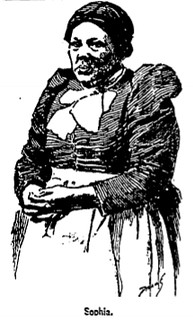 The basic printed source containing information on 19th century Federal employees is a US Government publication called the Official Register of the United States. In the late 19th century, when Mrs. Holmes worked for the government, the Official Register was published biennially in even numbered years and contained data on the Federal work force as of the summer or fall of the previous odd numbered year. It is readily available online on both the Internet Archive and Google Books, with the latter being the easiest to search.
The basic printed source containing information on 19th century Federal employees is a US Government publication called the Official Register of the United States. In the late 19th century, when Mrs. Holmes worked for the government, the Official Register was published biennially in even numbered years and contained data on the Federal work force as of the summer or fall of the previous odd numbered year. It is readily available online on both the Internet Archive and Google Books, with the latter being the easiest to search.
The earliest Official Register reference to Mrs. Holmes is in the volume covering 1863. A Mrs. S. Holmes is listed as a "female temporarily employed" in the Treasury Department and earning $216 a year. She possibly was in this position when she had her encounter with Spinner but if she was indeed still a temporary employee in 1863, it could mean the episode took place that year rather than in 1862 . It also is possible that the position listed in the 1863 volume was the better paid job she got as a reward for her honesty but for some reason, the Official Register entry described the position as temporary.
In the 1865 volume, Sophia Holmes is identified as a laborer in the Office of the Treasurer. Her salary was $24 a month. However in 1867 she is described as a messenger in the Register's Office earning $720 a year. Most laborers in the office earned $432 per year.
In 1869 and 1871, Mrs. Holmes' job title and salary remained the same. In 1873, however, her job title was assistant messenger but her salary was still $720. Three employees were listed as messengers in the Register's Office and they received $840.
In 1875, the year in which General Spinner left the Department, Mrs. Holmes is once again listed as a laborer. Her salary and that of the other laborers was $720. Messengers made $840. The Official Register gives no indication of why she was downgraded. Perhaps there were performance issues and of course racial prejudice may have played a role. However, it is also quite possible that she suffered as a result of her association with General Spinner. According to his Wikipedia biography, Spinner left his position at Treasury because of a dispute with the Secretary, who insisted on having the final say when it came to departmental appointments.
Entries in the Official Register for the remainder of Mrs. Holmes long career list her as a laborer, earning $660 a year. The last reference to her is in the volume that shows agency staffing as of 1895. Thus, she spent the vast bulk of her Federal career as a laborer who did janitorial work. I've attached scans of selected pages from the Official Register at the end of this article.
Additional information about Mrs. Holmes is available in entries for her on Wikipedia and Wikitree. Taken together they provide a great deal of data about her whole life, particularly the years prior to her becoming a Federal employee when she and the Mayor of Washington worked together to emancipate her enslaved husband. He ultimately joined the Union Army and died a hero at Bull Run. His death came to the attention of several major political figures whose efforts led to Sophia's first job at Treasury as a temporary, part time janitor.
These articles include useful data drawn from Census records. For example Mrs. Holmes could neither read nor write, which of course greatly limited her employment possibilities in the civil service. More importantly they provide links to 19th century sources particularly several newspaper articles written in the 1890s based on interviews with Holmes.
These articles are remarkably similar and include quotations attributed to Mrs. Holmes herself. Some were in fairly obscure local papers but others appeared in the Los Angeles Times, the Boston Globe, the New York Times, and the Washington Post.
The L.A. Times article is titled "Sophia, The Janitress of the United States Treasury Building" and appeared on June 11, 1893. According to the article she was first employed as a "scrub woman" at Treasury working every other day. She and the other women who held similar positions were called "Uncle Sammy's Scrub Brigade." The article recounts her meeting with Spinner and how shortly thereafter she was made a permanent employee. The article makes no reference to her ever being a messenger.
The Wikitree article itself does note Holmes' being made a messenger but incorrectly dates the appointment to 1869 when her title went from messenger to assistant messenger. It also implies incorrectly that she was an assistant messenger for the rest of her long career. Mrs. Holmes' biography on Wikipedia essentially repeats these errors.
There is possibly an even better source of information on Holmes than those discussed above. When someone applied for a government job in the late 19th century an application file was opened. According to historian Cindy Aron who used these records as the basic source for a book, if a person was hired the application file essentially became a personnel file documenting the employee's career. Aron specifically used files accumulated in the Treasury Department's Division of Appointments that are now held at the National Archives in College Park, Maryland. If this body of records includes a file on Holmes it would be the most accurate account of her career. The entry in the Archives catalog that pertains to these records may be accessed at archives.gov/research/guide-fed-records/groups/056.html#56.3.
Another possible source may be available in Civil War era congressional files at the National Archives in Washington at the National Archives in Washington and/or in records of the Treasury Department which are stored at the Archives facility in College Park.
In checking the Washington Post for articles on Mrs. Holmes, I found one published in 1954 that was written by a Francis de Sales Ryan, a retired Treasury Department employee. The article titled "1862 Theft Led to Stringent Security Rules," provides an exact date, October 10, 1862, for Mrs. Holmes meeting with Spinner as well as her initial salary, $15 a month. It also specifies the room number where the money was found. According to Ryan, after the episode there was a major congressional investigation which Ryan presumably was able to access. The article notes that this story would be included in a forthcoming book but I have not been able to verify that this book was ever published.
To see the full articles and documents Jerry provided, see this Flickr album:
Sophia Holmes
(https://www.flickr.com/photos/coinbooks/albums/72177720327054173)
Remarkable life story! -Editor
For more information, see:
Sophia Holmes
(https://en.wikipedia.org/wiki/Sophia_Holmes)
Sophia (Brown) Holmes (abt. 1825 - 1900)
(https://www.wikitree.com/wiki/Brown-114364)
To read the earlier E-Sylum article, see:
SOPHIA HOLMES, FIRST BLACK FEMALE FED
(https://www.coinbooks.org/v28/esylum_v28n24a13.html)
NOTES FROM E-SYLUM READERS: JUNE 22, 2025
Mystery Woman Studying Coins
Pete Smith writes:
 "Last week, The E-Sylum had a story "When Coins are Inherited." The article was illustrated
with a photo of a woman examining a coin collection. She was not identified.
Can any E-Sylum reader identify the woman or the coin she is holding? Send your response to
Wayne
before reading further. Spoiler Alert! The answers may appear elsewhere in this issue."
"Last week, The E-Sylum had a story "When Coins are Inherited." The article was illustrated
with a photo of a woman examining a coin collection. She was not identified.
Can any E-Sylum reader identify the woman or the coin she is holding? Send your response to
Wayne
before reading further. Spoiler Alert! The answers may appear elsewhere in this issue."
I can be reached at whomren@gmail.com. I knew the woman's name, but had guilty knowledge as editor of the article excerpt. But I hadn't thought about the coin and had no idea of what it was until I read Pete's excellent article. Check it out! -Editor
To read the earlier E-Sylum article, see:
WHEN COINS ARE INHERITED
(https://www.coinbooks.org/v28/esylum_v28n24a28.html)
Ribbon Circlet vs. Garter
Daniel Fearon writes:
"Dick Johnson's description of the riband or ribbon circlet, whilst correct in most cases, is not with the piece illustrated. The legend is within a Garter, as in The Garter of the Order of the Garter. I fear the Knights would not think much of wearing a riband or ribbon circlet!"
Thanks for setting this straight! It did look more to me like a belt than a ribbon, and the wording is the same as on the Order of the Garter. Can anyone supply a better example image of a coin or medal with a riband (or ribbon) ciclet? -Editor
For more information on the Order of the Garter, see:
Order of the Garter
(https://en.wikipedia.org/wiki/Order_of_the_Garter)
To read the earlier E-Sylum article, see:
VOCABULARY TERM: RIBBON CIRCLET
(https://www.coinbooks.org/v28/esylum_v28n24a11.html)
Cash in Books (Sort Of)
Mike Hodder writes:
"Back years ago I lost, then found, a gold ingot valued by its owner at $50,000. This was a thin rectangular poured ingot about the size of a pack of cigarettes weighing a few ounces. There were no logotype punches on the piece, just individual letter punches defining a maker along with the bar's weight and precious metal assay. The maker was unrecorded. The bar had been sent to John Ford for an opinion. He sent it to me for mine. When it arrived I got out my reference books, studied the piece, and told Ford by telephone I didn't have much confidence in it. Ford said I should return it to the owner as he knew I had it. When I hung up the phone I turned to get the ingot but couldn't find it on my desk. Over the next day I tore my office apart but still couldn't find it. As a last resort, and at my wife's suggestion, I checked inside every book I'd had open on my desk at the time I examined the ingot. Sure enough, it was inside a book listing western territorial gold assayers. It was thin enough not to have been noticed when I closed and re-shelved the book.
 "I had a friend who once lost an 1879 Flowing Hair Stella. He found it days later in the cuff of his trousers. He'd commuted by train to and from the office twice on different days wearing the same suit. When he got to the office after the second trip he sat at his desk and the Stella rolled out of his cuff.
"I had a friend who once lost an 1879 Flowing Hair Stella. He found it days later in the cuff of his trousers. He'd commuted by train to and from the office twice on different days wearing the same suit. When he got to the office after the second trip he sat at his desk and the Stella rolled out of his cuff.
"One might think special angels are appointed to mind fools."
Wow, great story! Below is another great one I heard from my numismatic mentor Glenn Mooney, who was a volunteer curator of the coin collection at the Carnegie Museum of Natural History. -Editor
Saint-Gaudens' son Homer was associated with the Carnegie Museum in Pittsburgh. I recall a story told by Glenn Mooney, one of the local volunteer curators who worked alongside head curator W.W. Woodside. Glenn said that Homer had arranged to donate an extremely high relief double eagle to the Museum's collection. For a time to coin was misplaced and no one could locate it. Eventually it turned up in the reference library – someone (probably Woodside himself) had accidentally closed a reference book with the coin inside. It was an embarrassing lapse, but everyone got a chuckle out of it at Woodside's expense. I assume this coin was part of the holdings sold when the Museum dispersed the bulk of the collection in the late 70s/early 80s. With these coins selling now in the multi-millions, it would have made for an interesting find in the stacks of the library (the coin department's reference library was transferred to the Carnegie Library of Pittsburgh in the early 80s).
To read earlier E-Sylum articles on the topic, see:
NUMISMATIC ETHICS
(https://www.coinbooks.org/esylum_v06n14a10.html)
GEORGE KUNZ AND THE EXTRA HIGH RELIEFS
(https://www.coinbooks.org/esylum_v08n49a12.html)
CELTIC COINS FOUND IN OLD COIN BOOK
(https://www.coinbooks.org/v22/esylum_v22n21a24.html)
Who or What Rates a Coin?
David Pickup passed along a reference to a Telegraph opinion article noting that Henry V would not get a commemorative coin from the Royal Mint (but other topics would). -Editor
On X Tony Diver writes:
" ... the Royal Mint rejected a new coin celebrating the warrior-king Henry V, on the basis that he is not "sufficiently significant" in British history. Mr Men and George Michael coins both approved."
David Pickup writes:
"To be fair I do not think the anniversary of Henry V's death is a hugely significant event. The anniversary of the battle of Agincourt was important but not marked on mainland British coins. A special coin was issued for one of the Channel Islands.
"The selection of what is a fit topic to feature on coin is not always straightforward and I think the Royal Mint do a good job generally. In 2022 the Royal Mint marked 25 years of the £2 Coin using the £2 coin from 1997, but with the number "25" in the central hologram. I am looking forward to 2047 when the mint can issue a coin to commemorate 25 years from the 25th anniversary of the two pound coin.
"What do readers think of missed important events or insignificant historical events that were commemorated?"
Great topic. Although one that may never have a definitive answer, it will always generate some interesting discussion. -Editor
To read the complete article (subscription required), see:
Royal Mint rejects Henry V coin in favour of Pride and Mr Men
(https://www.telegraph.co.uk/news/2025/06/15/royal-mint-rejects-henry-v-in-favour-of-pride-and-mr-men/)
To read the reference on X (formerly Twitter), see:
https://x.com/wallaceme/status/1934573614172692718
1923 German Inflation Notes
Pablo Hoffman passed along this great 1923 photo of a banker counting packs of German inflation notes in a Berlin vault. Thanks! -Editor
The Drummer Boy Quarter Controversy
Mike Costanzo writes:
"Wayne Pearson's photo of the drummer boy depicted on a 1973 stamp and Jack Ahr's Bicentennial quarter design sparked a memory: Ahr's design had received criticism as early as 1975 that he had plagiarized it. Eventually Mint Director Mary Brooks came to Ahr's defense and said that although his design and the stamp appeared similar, Ahr's design still displayed enough originality. Even Walter Breen got into the fray and said both designs were probably inspired by the "Spirit of '76" painting from 1876.
"I've also liked Ahr's design and believe it fit nicely on the quarter while Huntington's Independence Hall design on the half dollar appeared bland. Dennis Williams' Moon and Liberty Bell motif on the dollar remains the standout. Hard to believe the 1969 moon landing happened just seven years prior to 1976!
"But I really shouldn't complain because 50 years ago these coins were already in circulation, while today we still have nothing numismatic to show for the upcoming semiquincentennial. Makes you wonder if the Mint is too busy making Superman coins instead of celebrating 250 years of history."
I remember that, now that you mention it. I guess I'm of a mind with Breen - both designs likely had a similar inspiration. -Editor
To read the earlier E-Sylum article, see:
NOTES FROM E-SYLUM READERS: JUNE 15, 2025 :
Bicentennial Stamp and Coin Drummer Design
(https://www.coinbooks.org/v28/esylum_v28n24a09.html)
Medal of Merit
Many thanks to everyone who wrote to congratulate me on my ANA Medal of Merit. -Editor
Joel Orosz writes:
"If ever there was a numismatist who received the Medal of Merit based strictly upon the merits of the case, that numismatist is you! It's great to see your innumerable contributions duly recognized by the ANA."
Bob Leuver writes:
"Congratulations on the honor to be bestowed by ANA, The Medal of Merit. It is so easy for an organization to lose sight of those who have championed the ideal of the organization or those involved in the efforts of the organization. As an editor of numismatics you have informed many numismatists of facets of the hobby and rekindled their interest or further developed their interest in the hobby!"
Chriss Hoffman writes:
"This award is very well deserved. Thank you for all the tireless hours you put into making The E-Sylum one of the very best things about our hobby, and for bringing all of us numismatists together every Sunday evening."
Thanks also to Eric Hodge, Jim Haas, Martin Kaplan, Bob Steinberg, Steve Roach, Vic Mason, Jeff Starck and others.
To read the earlier E-Sylum article, see:
ANA ANNOUNCES 2025 SERVICE AWARDS
(https://www.coinbooks.org/v28/esylum_v28n24a07.html)
More on the Michael Dolley Lectures
 Regarding the Northern Branch of the Numismatic Society of Ireland public lecture that was held at the Ulster Museum recently,
Zach Filis writes:
Regarding the Northern Branch of the Numismatic Society of Ireland public lecture that was held at the Ulster Museum recently,
Zach Filis writes:
"The presentations were quite good and they will be presented again at the British Numismatic Society meeting on 11 July. Both Kristin Bornholdt Collins and John Rainey among others will be presenting.
"The NSI-NB has commissioned a 40mm medal of Michael Dolley that will be produced at the Fattorini mint in both silver and bronze. The artist of the medal is Danuta Solowiej."
To read the earlier E-Sylum article, see:
MICHAEL DOLLEY AND IRISH NUMISMATICS
(https://www.coinbooks.org/v28/esylum_v28n24a14.html)
Signed by James Jarvis
Tony Terranova writes:
"Sometimes you stumble on something you never saw before. Signed by the fellow that finagled the contract for our Fugio cents."
Interesting - great find! -Editor
The Nelson Bunker Hunt Catalog
 Mike Costanzo writes:
Mike Costanzo writes:
"I always knew Nelson Bunker Hunt caused the great 1979-80 silver meltdown, but was surprised to discover he was apparently also a numismatist. I'm pretty sure he didn't collect any Franklin Mint issues."
The man who could afford to buy almost anything bought a lot of everything. -Editor
Canada's Coat of Arms Changes
Wayne Pearson writes:
"Were you aware that Canada modified their coat of arms on the reverse of their half dollar in 1997? You wouldn't notice it without a magnifying glass. You can see the red circle that was added around the shield in these pictures."
Interesting. There are multiple differences in the shields. No, I hadn't noticed that. Thanks. -Editor
The Old Librarian's Almanack
Mike Costanzo writes:
 I recently came upon a small volume titled "The History of a Hoax: Edmund Lester Pearson, John Cotton Dana, and The Old Librarian's Almanack." Published in 1979 by Wayne A. Weigand, who authored several books covering libraries, the book tells the story of a playful "hoax" perpetrated in 1909 by two bored librarians. Pearson and Dana believed librarians were no longer held in high regard and wanted to publish something that got their message across that librarians, like preachers, served a high calling.
I recently came upon a small volume titled "The History of a Hoax: Edmund Lester Pearson, John Cotton Dana, and The Old Librarian's Almanack." Published in 1979 by Wayne A. Weigand, who authored several books covering libraries, the book tells the story of a playful "hoax" perpetrated in 1909 by two bored librarians. Pearson and Dana believed librarians were no longer held in high regard and wanted to publish something that got their message across that librarians, like preachers, served a high calling.
To draw attention, they inserted their writings among pages of an old obscure almanac claimed to have been published in 1774. They claimed that a single copy existed and also went to great lengths to fake auction records. Once the reprint was published, Pearson and Dana enjoyed reading reviews from major academic journals hailing the Almanack as a "major discovery."
Once the hoax was revealed both men admitted the ruse. What makes the volume interesting is Pearson and Dana's opinion that books were sacred objects and libraries should be valued. They also go into great detail about the care and maintenance of books. They also discuss book thieves, and sprinkled limericks supposedly written from 1774. Among them is this one:
On gallows fifty cubits high
Hang the wretch and let him die,
A dozen of my books he stole,
May God have mercy on his soul.
I bet it would make a good bookplate !
Hear, hear! And screw the mercy! -Editor
THE COIN MAKEOVER AMERICA NEEDS
Jim Huntington published the following blog post about the U.S.'s current circulating coins. We're republishing it here with permission. -Garrett
I grew up in the 1960s. My allowance was nowhere near a dollar a week, and I had respect for all of it. I could spend a penny by itself – at a local toy store, it would buy a piece of candy. A dime would get me a small bag of that, or two small but ordinary Hershey's bars. A quarter, or at least 29 cents plus Chicago's 4% sales tax, would fetch my choice of several plastic toys. It was rare for me to have a dollar bill – I mostly only managed that at Christmas, or a few times when selling lemonade. The rest of the year the only money I handled was coins. A pocket full of them was a pocket full of possibilities.
Now it's 60 years later. Prices have risen roughly tenfold, but what we buy things with, except for effectively losing the half dollar and gaining the rarely-seen dollar coin, is the same. A pocketful of our coins is, to many, a nuisance, as even a quarter has less spending value than one cent did in the 1940s.
 Is this an appropriate situation? Our Department of Government Efficiency has recently said it is not. As a result, the current administration, per "Treasury Department to halt penny production after centuries in circulation" (Sophia Compton, Fox News, May 22nd), "is phasing out production for the penny," "made its final order of blank pennies this month and will stop putting one-cent coins into circulation by early 2026." Their cost apiece, since 2015, has moved from "a little over 1 cent to nearly 4 cents."
Is this an appropriate situation? Our Department of Government Efficiency has recently said it is not. As a result, the current administration, per "Treasury Department to halt penny production after centuries in circulation" (Sophia Compton, Fox News, May 22nd), "is phasing out production for the penny," "made its final order of blank pennies this month and will stop putting one-cent coins into circulation by early 2026." Their cost apiece, since 2015, has moved from "a little over 1 cent to nearly 4 cents."
However, that will bring another coin problem to the front of the line. Per a February 11th post on Hero Bullion, nickels are now running us 13.8 cents apiece. With only the penny being discontinued, demand for nickels will probably increase, but even if it doesn't, that's a lot. Even if we also cut out these 5-cent coins, we are facing upcoming dangers from the dime (5.76 cents apiece) and quarter (14.7 cents apiece). We need a longer-term solution.
Other affluent countries have done far better. Those using the euro have had three coins worth more than our quarter for up to 23 years. Canada discontinued its one-cent coin in 2012, and has two higher than ours. Since 2016, Sweden has had only four circulating coins, with the face value of the lowest, 1 krona, about 10 cents, and the 5 and 10 kronor worth more than any truly circulating American coin. Switzerland is now up to five coins out of seven valued higher than 25 U.S. cents, and Japan, despite its currency value shrinking, still has three. In such places, almost all coins worth less than one US cent have either been ended or have long since left circulation.
It's past time for a full-scale makeover of United States circulation coinage.
I recommend we discontinue all four of our common circulating denomination coins. We should replace them with a 10-cent (not "dime," an antiquated term worthy of retirement) issue, and a 50-cent (not "half dollar") piece. Both should be minted from an alloy made almost completely of copper, at Tuesday's $4.91 per pound price hardly cheap but, for higher face values, reasonable. The 10 cents should be slightly larger than the current penny, and the 50 cents a little bit smaller than today's quarter. After creating designs visually different from our existing coins, we could continue by putting Abraham Lincoln's image on the 10 cents and Thomas Jefferson on the 50.
For a third coin, we will need to honestly address the situation with our one-dollar notes. Only if we stop making them will $1 coins take to common circulation. I understand there are international reasons why this bill is still being made, but there are real savings achievable if we can replace them, within America itself if nowhere else, with more durable alternatives. The latest size and composition would be good enough, if it had no entrenched competitor. I would choose George Washington on the front.
Two other matters will need attention. First, despite Canada's success with its $2 "toonie," we should not attempt a two-dollar coin, as throughout American history people have overwhelmingly rejected all money with two-cent and two-dollar face values. Second, we should not demonetize any discontinued coins. Four-drawer cash registers will have room for mixed old ones, and of course banks would continue to accept them.
As well as savings on manufacture, this plan would greatly reduce coin handling, which pushes up labor costs. By not using the second number to the right of the decimal point, there would be no rounding issues, which have stopped many people from accepting the penny's removal. While some would take it as cheapening if we had less expensive-looking coins, others would welcome the end of so many with almost no purchasing power. With continued inflation control, we would not need to consider size-and-composition changes for decades. The overall savings for the American people would certainly be in the hundreds of millions of dollars and probably in the billions.
Can we support this potentially bipartisan proposal? I think we can. It might start us on the way to agreeing on more things. And the reminder that we made it work would be right in our pockets.
To read the complete article, see:
The Coin Makeover America Needs
(https://worksnewage.blogspot.com/2025/06/the-coin-makeover-america-needs.html)
VOCABULARY TERM: RIBBON
Here's another entry from Dick Johnson's Encyclopedia of Coin and Medal Terminology. I added a couple images. -Editor
Ribbon. The narrow cloth strips from which small medals are suspended. Medals of valor, military decorations, campaign medals, Olympic, some sports and educational awards, as well as others, have medallic items suspended from such cloth ribbons. The ribbons are a means of adding color, class, distinction, identification and substitution for such medallic awards in addition to providing a means for suspension for the medal to be worn.
An elaborate color code has evolved for American military medals, and this is true for England, France and nearly every country with military forces. Ribbons include other significance as well. The Victoria Cross, for example was bestowed to soldiers with red ribbon, for sailors, the ribbon was blue.
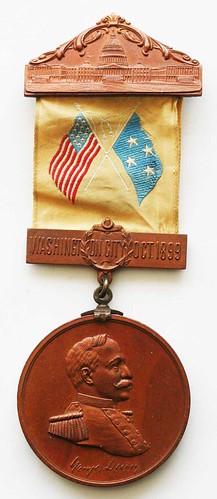 Ribbon terms. The largest of such cloth ribbons is the sash, which hangs over one shoulder across the body to the opposite side at the waist. This is substantial enough to support a heavy pendant medal.
Ribbon terms. The largest of such cloth ribbons is the sash, which hangs over one shoulder across the body to the opposite side at the waist. This is substantial enough to support a heavy pendant medal.
The neck ribbon supports a medal hung around the neck. This is most popular and is the one used for Olympic and other sports awards.
But the most popular one is the ribbon drape that supports a medal and is attached to a stem and clasp by which it can be fastened to a garment. There are several ways of folding the ribbon drape and the ends are sewn together after a ring is placed in the fold. A second ring (as a jump ring) supports the medal.
When a medal is intended to be worn in front of the ribbon (as both elements suspended from the same header) the ribbon in this position is known as the backribbon.
Its color should be in contrast to the color of the medal.
Ribbons are made of cotton or silk, and more recently of rayon; they can be flat or braided. The finish of the cloth can be of several kinds – gros grain (most durable), satin finish, moire and velvet. Ribbons are decorated with bullion embroidery, metal thread, often made into tassels.
Some ribbon substitutes have been used. Indian Peace Medals have been suspended with thongs of leather. Other ribbon substitutes include cord and colored string.
When designing a ribbon for a medal it should be kept in mind that the ribbon should be the same width as the medal, the ribbon drape and medal should be no wider than 1 3/4- inch. A neck ribbon may support a wider medal but the weight should be taken into consideration.
Ribbons do tend to soil and fray with extensive wear. They have the advantage that they can be replaced with fresh ribbon. Original ribbon and replacement ribbon are terms used by collectors to differentiate these when it can be so determined.
Cataloging ribbons. It is usually sufficient to identify the color of ribbons in cataloging such medallic pieces. Numismatic custom is to identity the colors from left to right. Hyphens (sometimes slash marks) are used to connect the colors: red-white-blue-white-red. Such a ribbon would have a single blue stripe down the center and the border color is red on both sides.
Ribbon as design elements. Infrequently a coin or medal will contain a ribbon as part of their design, often having lettering appearing on them. Such ribbons show folds, waves, and their ends are frequently notched for artistic effect. They are also called banderole.
Ribbons are also found in wreath designs, as a tie at the bottom; these are called ribbon ties. A circular ribbon, often with lettering and with a buckle below is known as a riband circlet or ribbon circlet.
Ribbon Bank. An accumulation of many ribbons for use by collectors and others to draw upon when desirous of replacing a worn or tattered ribbon drape, neck ribbon or such. The Orders and Medal Society of America maintains such a ribbon bank for their members. Also private ribbon banks exist, and, infrequently medal manufacturers may have a small cache of unused ribbon. Ribbon manufacturers are generally not a source of short length of ribbon, demanding a sizeable minimum order (500 yards or more) to manufacture new ribbon. They cite the huge effort and expense to setup their looms to make such ribbon.
To read the complete entry on the Newman Numismatic Portal, see:
Ribbon
(https://nnp.wustl.edu/library/dictionarydetail/516652)
EDNESS KIMBALL WILKINS (1896-1980)
E-Sylum Feature Writer and American Numismatic Biographies author Pete Smith submitted this article on collector Edness Wilkins. Thanks! -Editor
 Edness Merrick Kimball was born in Casper, Wyoming, on January 31, 1896. She was the
daughter of Wilson S. Kimball, Sr. (1866-1952) and Edness Jane Merrick Kimball (1867-1912).
Her father had served as mayor of Casper for ten terms. The family was well-to-do with large oil
interests, ranching and a string of drug stores.
Edness Merrick Kimball was born in Casper, Wyoming, on January 31, 1896. She was the
daughter of Wilson S. Kimball, Sr. (1866-1952) and Edness Jane Merrick Kimball (1867-1912).
Her father had served as mayor of Casper for ten terms. The family was well-to-do with large oil
interests, ranching and a string of drug stores.
Edness Kimball graduated from Casper High School in 1914. She was class president and valedictorian. This was a girl with great potential.
She attended Ward-Belmont College in Nashville in 1914. Then she transferred to the University of Kentucky for the 1915-16 school year. In 1916, she was proclaimed as one of the four most popular and beautiful girls at the school. At school she was a reporter for the college newspaper. Back home in Casper, she was the society editor for the Natrona County Tribune. Later she attended the University of Nebraska, studying journalism.
She was married in Casper, Wyoming, on November 3, 1917, to Lloyd Mosler Tully (1895-1949) and moved to Alliance, Nebraska. Mr. Tully was a law school graduate and manager of his father's extensive estate. Mr. Tully was drafted into the Army a few months after the wedding. They had a son, Charles Henry Tully (1920-1988).
She worked in the office of the Wyoming state auditor in Cheyenne in about 1925 to 1927. Lloyd Tully was no longer mentioned after about 1924.
On May 22, 1926, Wyoming Governor Nellie Tayloe Ross attended a luncheon hosted by Mr. and Mrs. W. S. Kimball at the Casper Country Club. Among the dozen guests was Mrs. Edness Kimball Tully of Cheyenne.
She was married in Denver on October 6, 1928, to Captain Roland Wilkins (1887-1933). She joined her husband stationed at Fort Russell (renamed Fort Warren in 1930) near Cheyenne. He died of a heart attack on February 20, 1933, while serving at Schofield Barracks in Hawaii. He was buried at Arlington National Cemetery,
On May 22, 1933, it was announced that Edness Kimball Wilkins was appointed as private secretary and administrative assistant to Nellie Tayloe Ross, the Director of the Mint. She began work in July and became an unofficial Mint historian.
Edness Kimball Wilkins joined the American Numismatic Association in August of 1936 as member 5536. In 1937 she was appointed to the Reception Committee for the ANA Convention to be held in Washington, D.C.
She was a member of the Washington Numismatic Society. In 1938 she offered an exhibit of presidential medals. On February 6, 1939, she exhibited a 1792 half disme, In 1940 she was elected Secretary. In 1943 she made a presentation on Mint Presidential medals.
Promotion for the 1937 ANA Convention included a story on a woman member of the host club. Edness Wilkins was featured with a large photo in an article in The Evening Star (Washington) on August 25, 1937. Across the top of the page was the headline, "Secretary to Director of the Mint Tells Fascinating Lore of Coins." The article was repeated in the Casper Star Tribune for September 5, 1937. She displayed what was described as an 1804 Dollar, one of 13 known. Her name is not associated with any of the known examples.
I enjoyed this quote from the article:
"But this one is my prize," said our hostess tenderly unwrapping a tiny packet. And there were two of the first coins minted in the United States – "half dismes," made at the Philadelphia Mint in 1792 from the Washington silver. The story goes that the general was most anxious for the infant republic to start a coinage system and decided to help matters along. So he took the family silver to the mint, two doors away, and offered it as raw material for our first coins. Mrs Wilkins was very happy over obtaining the two worn little "dismes" at a recent coin auction. "Nobody was paying attention to them," she said. "Until I got them. My knowledge of mint history stood me in good stead there."
In 1935, M. H. Bolender sold a VG 1792 half disme at auction for $8.00. This may not be one of the pieces mentioned, but gives an indication of current market value.
Another article on Edness Wilkins appeared in The Evening Star for April 18, 1938, The Buffalo News for April 21, Pasadena Star-News for April 21, Battle Creek Moon-Journal for April 23, The Star-Press for April 24, The Casper Tribune-Herald for April 27, and The Oregon Daily Journal for May 8. Each of the articles included a version of the photo of Wilkins examining a coin.
The Library of Congress has a file copy of the Wilkins photograph. The description includes much of what was included in the newspaper articles. The description has her name misspelled.
"Coin Collector." Washington, D.C., April 11. Edness Wilkens, Secretary to Nellie Tayloe Ross, Director of the Mint, for the last four years has been collecting coins as a hobby, thru gifts, trades, and buys, she has a collection of over 400 coins ramping from half pennies to the old silver cartwheels, she is shown inspecting a half-dime, one of the first struck from the Philadelphia Mint in 1792, and Mint tradition has it that the silver it contains is from the tableware of Martha Washington, she at that time lived two doors down from the Mint, and gave part of her silverware for the first coins, April 11, 1938." (the date of the photo)
This article indicates that the Mint was promoting the Martha Washington story, based on tradition rather than Mint records.
The large photo and its cropped version have been reproduced many times, often without attribution. It has been used as a generic picture of a woman coin collector.
In September 1947 she retired from the Mint to return to Casper, Wyoming, and to care for her ailing father who had recently retired. In October 1947 she gave a talk to the Casper Lions Club. She stated that "The history of a nation is written in its coinage,"
Wilkins worked in the personnel department for the U. S. Bureau of Reclamation. Then she managed the Casper Water and Sanitation Department. When the water and sanitation departments were split, Wilkins managed the sanitation department. On April 3, 1951, the Casper City Council abolished her position.
Following the 1952 death of her father, Edness filed for a seat in the Wyoming legislature. In 1954 she was elected to the Wyoming House of Representatives and served 1955 to 1967.
She was selected to be Speaker of the Wyoming House of Representatives and served May 30. 1966, to January 9, 1967. However, she served in the second year of the legislative session when the House did not meet. She was the last Democrat to have that title in Wyoming.
She was elected to the Wyoming Senate and served January 9, 1967, to January 12, 1971. She returned to the Wyoming House of Representatives and served from 1972 until her death in 1980.
Edness died in Casper, Wyoming, on July 15, 1980, and is buried with her parents at Highland Cemetery in Casper. Her death was noted in the May 1980 issue of The Numismatist as member R-14978.
The Edness K. Wilkins State Park was established at a former rock quarry purchased by the state in 1981. It is located about six miles east of Casper, Wyoming. Is there any state park named for a male numismatist?
The Wilkins photo (misspelled Wilkens) was reproduced on page 79 of the April 2010 issue of The Numismatist.
In our book, 1792: Birth of a Nation's Coinage, we list pedigrees for about 165 1792 half dismes. This is followed by an alphabetical list of coin owners. Of the 129 names listed, four are women.
The coins owned by Edness Wilkins cannot be linked to a photo or pedigree. While it is unusual for a woman to collect one, it is unique for her to have two.
Most past owners remain unidentified. Many of the pedigrees have coins from an unidentified consignor passing through an auction to an unidentified buyer (63). Any of these could have been owned by a woman.
To read the earlier E-Sylum article, see:
WHEN COINS ARE INHERITED
(https://www.coinbooks.org/v28/esylum_v28n24a28.html)
NUMISMATIC TREASURES AT OKLAHOMA ANA
Many very important numismatic items will be displayed at the 2025 World's Fair of Money in Oklahoma City. -Garrett
Some of the most famous national numismatic treasures will be displayed for the first time in the Sooner State during the American Numismatic Association's 2025 Oklahoma World's Fair of Money (WorldsFairOfMoney.com) at the Oklahoma City Convention Center, August 19-23, 2025. ANA members are encouraged to pre-register for the show to skip the registration line. Pre-registration ends July 25.
"We are proud to display historic rare coins and bank notes for the first time in Oklahoma for the public to enjoy at our family-friendly, educational event," stated Thomas J. Uram, president of the 25,000-member American Numismatic Association (ANA). "This will be a chance for many people in the southwest to see these remarkable items in person."
Among the multi-million dollar exhibits from the ANA's Edward C. Rochette Money Museum in Colorado will be the McDermott-Bebee 1913 Liberty Head nickel; the Cohen Class I 1804 Draped Bust silver dollar; an exhibit of rare, early American paper money from the First and Second Bank of the United States that operated between 1791 and 1836; and a $100 trillion denomination bank note from Zimbabwe, one of the world's most unusual pieces of paper money.
The Museum Showcase (table #1133) will also present an exhibit of selected items from the ANA museum's collection of Renaissance medals of the late 14th to early 17th centuries. They showcase the creativity of the cultural revival in Europe that led to the development of an important part of numismatics, the portrait medal.
The Museum Showcase also will include from the famous Tyrant Collection (TheTyrantCollection.com) a superb 1907 Ultra High Relief Double Eagle. Described by many experts as America's most beautiful coin, this $20 denomination gold piece was in the estate of the famous coin's designer, acclaimed sculptor Augustus Saint-Gaudens. There will also be a rare 1792 hand-engraved George Washington Indian Peace Medal, one of the few known remaining examples of highly prized diplomatic gifts between the U.S. and American Indian nations.

1907 Ultra High Relief $20 from the Tyrant Collection,
once in the estate of the famous coin's designer,
Augustus Saint-Gaudens.
Some of the world's earliest coins will be displayed in the Museum Showcase, dating back to the mid-to-late 7th century B.C. Composed of electrum, an alloy of gold and silver, these historic ancient coins were made in Asia Minor and will be exhibited courtesy of collector John Nebel for the first time in Oklahoma.
GreatCollections (GreatCollections.com), the Official Auctioneer of the ANA, will display their unique pair of New Orleans Mint 1844 $5 and $10 proof gold coins, reportedly the first time in more than a century the two have been together in public. Now part of The Elite Collection, the coins are owned by an anonymous collector who is giving the public the once-in-a-century opportunity to see them together at the GreatCollections table (#1000).

The two rarities will be displayed at the ANA World's Fair of Money in Oklahoma; Not seen together since the 1890 Parmelee auction.
During the convention, more than 500 dealers from across the United States and abroad will be buying and selling rare coins, vintage paper money, medals, tokens, and gold and silver. Many of the on-site numismatic experts will provide free, informal evaluations of the public's old coins and paper money.
Educational seminars and a children's treasure trivia game will be offered during the show, as well as family-friendly activities.

This electrum stater of King Croesus of Lydia 561-550 BC is one of the ancient coins that will be displayed in the Museum Showcase.
The 2025 World's Fair of Money will be held in Hall B of the Oklahoma City Convention Center at 100 Mick Cornett Dr. in Oklahoma City. The show will be open to the public on Tuesday, August 19, 2025 from 1 p.m. to 5 p.m.; Wednesday through Friday, August 20-22, from 10 a.m. to 5 p.m.; and Saturday, August 23, from 10 a.m. to 3 p.m.
Admission is free for ANA members and children 12 and under, and $10 for non-member adults Tuesday through Friday. Admission is free for everyone on Saturday.
Additional information about the convention and hotels in the area can be found online at WorldsFairOfMoney.com.
PHILIPPINE COLLECTORS FORUM AT OKLAHOMA ANA
The Philippine Collectors Forum will hold its annual gathering at the ANA's World's Fair of Money on Friday, August 22, 2025, in Oklahoma City. Dennis Tucker will present a talk entitled, "Melecio Figueroa: The Saint-Gaudens of the Philippines." -Garrett
 The Philippine Collectors Forum will hold its annual gathering at the American Numismatic Association's summer convention (the World's Fair of Money) on Friday, August 22, 2025, in Oklahoma City. The PCF meeting is free and open to the public. Highlights include custom ANACS-slabbed commemorative coins for the first fifteen attendees, Philippine money–related door prizes, and 1940s Japanese Invasion currency from World War II. Educational features include a keynote lecture, market and auction reports, book reviews, and research updates from experts in the fields of Spanish and American Philippine coins, tokens, medals, and paper money.
The Philippine Collectors Forum will hold its annual gathering at the American Numismatic Association's summer convention (the World's Fair of Money) on Friday, August 22, 2025, in Oklahoma City. The PCF meeting is free and open to the public. Highlights include custom ANACS-slabbed commemorative coins for the first fifteen attendees, Philippine money–related door prizes, and 1940s Japanese Invasion currency from World War II. Educational features include a keynote lecture, market and auction reports, book reviews, and research updates from experts in the fields of Spanish and American Philippine coins, tokens, medals, and paper money.
"The field of U.S./Philippine currency has been very active in recent years," said PCF Secretary John Riley. "Not only are prices in the market rising, but researchers in the United States as well as the Philippines have been studying the historical record and publishing interesting new finds. Philippine coins have been newly featured in major hobby publications including the Greysheet and the Cherrypickers' Guide to Rare Die Varieties. Paper money, too, has seen a vibrant market and significant new publications in recent years. This is an exciting time to be a collector."
 Dr. Earl Honeycutt, coauthor with Sandy Lichauco of Philippine Medals and Tokens 1780–2024
(fourth edition, 2024), notes that it's not only coins that have seen fresh interest lately. The
market for Philippine tokens and medals has also blossomed. Ongoing research has added
hundreds of additional pieces to the latest edition of Honeycutt's groundbreaking book. "There
are opportunities for smart buyers as well as sellers," he said.
Dr. Earl Honeycutt, coauthor with Sandy Lichauco of Philippine Medals and Tokens 1780–2024
(fourth edition, 2024), notes that it's not only coins that have seen fresh interest lately. The
market for Philippine tokens and medals has also blossomed. Ongoing research has added
hundreds of additional pieces to the latest edition of Honeycutt's groundbreaking book. "There
are opportunities for smart buyers as well as sellers," he said.
The keynote speaker of the 2025 Philippine Collectors Forum is award-winning author Dennis Tucker, a Life Member of the Filipino American National Historical Society and former numismatic specialist on the U.S. Treasury Department's Citizens Coinage Advisory Committee. He will present a history and appreciation of Melecio Figueroa, the designer of the 1903–1945 Philippine coinage minted under American administration.
In his talk, titled "Melecio Figueroa: The Saint-Gaudens of the Philippines," Tucker will make the case that Figueroa's work is far more innovative and historically significant than he's been given credit for. "Every American coin collector who knows Charles Barber, George T. Morgan, and Augustus Saint-Gaudens should also know their Philippine contemporary, Melecio Figueroa," Tucker said.

Dennis Tucker (left) and The Hon. Steven J. Robinson, Australia's Ambassador to the Philippines, July 15, 2022. At the opening of the Philippine World War II Memorial Foundation's "Remembering World War II" exhibit at Fort Santiago, Intramuros, Manila.

Dennis Tucker (right), Dr. Alexander Santos, and The Hon. Dra. Honey Lacuna, Mayor of Manila, July 15, 2022. At the opening of the Philippine World War II Memorial Foundation's "Remembering World War II" exhibit at Fort Santiago, Intramuros, Manila.
The Philippine Collectors Forum is a club member of the congressionally chartered American Numismatic Association. Membership in the PCF is free, and attendees don't have to pay the convention's entrance fee to attend the PCF's 2025 annual meeting. It will start at 1:00 pm in Room 106 (first floor, at the far-right end of the lobby) of the Oklahoma City Convention Center.
NUMISMAGRAM MEDAL SELECTIONS: JUNE 22, 2025
Numismagram's Jeremy Bostwick sent along these five medals from his most recent upload of new material to his site. For all of the new items, please visit https://www.numismagram.com/inventory. -Garrett
103212 | ITALY. Dionisio Ratta of Bologna cast bronze Medal. Dated 1592, and issued circa early-mid 17th century (66mm, 119.98 g, 11h). By Felice Antonio Casoni, fl. 1592-1634. + DIONYSIVS DE RATA VTR SIC REF ETS INQVISIT PRAELATVS CONS, cloaked bust right // DIVO / PETRO MARTVRI / TEMPLVM EREXIT / ET SEPVLCHRVM / SIBI CONSTRVXIT / SEDENTE / CLEMENTE VIII / PONT MAX / A D MDXCII (he erected the temple of Saint Peter, the martyr, and constructed his sepulcher, with the Pope Clemens VIII reigning in the year of the lord 1592) in nine lines. Edge: Some light marks as made, otherwise plain. Pollard 547 = Kress 476 (also holed at the top). Choice Extremely Fine. Warm red-brown surfaces, with some chasing on the higher points; pierced at the top. Ex Michael Hall Collection, part III (Baldwin's 67, 28 September 2010), lot 2292. $495.
Pollard, in Renaissance Medals, writes that "...Dionisio Ratta (d. 1597) of Bologna graduated from Bologna University on 19 March 1572 and became one of the Giudici di Collegio in that year. He held various offices in Rome, such as auditor of the Rota, a sacred court of the Catholic Church. The reverse inscription records the construction of the Church of Saint Peter Martyr in Bologna and the erection of Ratta's tomb. The foundation stone was laid in 1592. Dolfi noted that medals of Ratta were placed in the church's foundations." About the artist of this medal, Felice Antonio Casoni, he writes that "...Casoni was born in Ancona and died in Rome. He was trained in Bologna and was employed there as early as 1592. Casoni is recorded as the architect of conventional buildings in Rome and as a sculptor, wax modeler, and medalist. Six medals are attributed to him, four of which are dated 1592."
To read the complete item description, see:
103212 | ITALY. Dionisio Ratta of Bologna cast bronze Medal.
(https://www.numismagram.com/product-page/103212)
103193 | UNITED STATES, CANADA & WESTERN EUROPE. George II brass Medal. Issued 1759. British victories of the year (43mm, 32.83 g, 12h). GEORGIVS • II • REX •, laureate, garlanded, and armored bust left // Shield with an inverted fleur-de-lis surrounded by garter with PERFIDIA EVERSA and plain roundels; below, ribbon inscribed W. PITT AUSP. GEO. II PR. MI.; around, list of campaigns and their commanders: QUEBEC / WOLFE / MONCKn.TOWNSd. / SEP.13 & 18 | CROWN POINT / AMHERST / AUG.4 | LAGOS / BOSCAWEN / AUG.19 | MINDEN / FERDINAND / AUG. 1 | GUADALOUPE / BARINGn. MOORE / MAY. 1 | NIAGARA / IOHNSON / IULY 25 | HAWKE / QUIBERON / NOV. 20. Edge: Plain. Betts 418; Ford XIV, 62-65; MI-708/444; Eimer 677. About Uncirculated. Deep brown surfaces, with some lighter tan hues nearer the peripheries. A great medallic issue pertaining to Colonial America and the French & Indian War. $365.
Sometimes referred to as 'World War Zero,' given its scale overall number of belligerent powers, the Seven Years' War began primarily with Austria's desire to recover Silesia from the Kingdom of Prussia. Since Great Britain had been aiming to increase her colonial possessions in the New World at the expense of France, the strife in the American theater began to merge with that in Europe, resulting in a legitimate global conflict, with every major European power taking the side of either Great Britain/Prussia or France/Austria. In addition to North America and Europe, skirmishes also played out in Central America, the western coast of Africa, India, and the Philippines. Ultimately, a peace was achieved through the Treaty of Paris, formally ending all conflicts save for the Silesian question; the Treaty of Hubertusburg, signed five days later, ended the issue between Prussia and Austria, formally ending the war. This medal celebrates British successes against the French in the Americas (Battles of Guadaloupe [West Indies], Niagara [New York], Crown Point [New York], and Québec [Canada]), as well as in Europe (Battles of Minden [Prussia] and Lagos [Portugal]). The subtle satirical nature takes form in the inverted fleur-de-lis at the center of the reverse.
To read the complete item description, see:
103193 | UNITED STATES, CANADA & WESTERN EUROPE. George II brass Medal.
(https://www.numismagram.com/product-page/103193)
103192 | BELGIUM. Art Deco bronze Medal. Issued 1951 for the 25th anniversary of the founding of the NMBS/SNCB (National Railway Company of Belgium) (69mm, 146.97 g, 12h). By Marcel Rau. Heads of Hermes/Mercury, wearing winged petasos, and Demeter/Ceres, wearing grain wreath, left; wheel with thunderbolt below // Outline of Belgium, with map of the rail routes; company logo below. Edge: FISCH. Choice Mint State. Tan-olive surfaces, with a pleasing matte aspect. An attractive Art Deco design. Includes original roundelle of issue, though a bit distressed. $245.
Known in Dutch as the Nationale Maatschappij der Belgische Spoorwegen (NMBS) and in German as the Nationale Gesellschaft der Belgischen Eisenbahnen (SNCB), the National Railway Company of Belgium was formed in 1926 as a successor to the Belgian State Railways. The logo of the company was designed 10 years later by Henry van de Velde, and consists solely of the linguistically neutral letter B (indicative of the country) within a horizontal oval, as can be seen on the reverse of this medal.
To read the complete item description, see:
103192 | BELGIUM. Art Deco bronze Medal.
(https://www.numismagram.com/product-page/103192)
103178 | ITALY. Vatican City. Pope Pius XII silver Medal. Issued Year XV (1953). Commemorating the Papal Consistory (44mm, 33.35 g, 12h). By Aurelio Mistruzzi at the Rome mint. PIVS • XII • PONTIFEX • MAX • ANN • XV, bust right, wearing zucchetto, stole, and pallium // EX • MVLTIS• GENTIBVS • PVRPVRATORVM • PATRVM • ORDO • COMPLETVS, Pius, surrounded by cardinals, seated left on throne, blessing new cardinal kneeling to left, and presenting him with a galero. Edge: Plain. Bartolotti E953; Rinaldi 147; Cusumano-Modesti 204. Gem Mint State. Exceptionally brilliant and prooflike, with some alluring pastel toning nearer the peripheries. $195.
Consistories in Catholicism represent times at which a pope can create new cardinals, adding them to the College of Cardinals. Due to death or retirement, the number of cardinals decreases, creating the need for periodic additions during such consistories. Pius XII was elected to the papacy in 1939 during a conclave consisting of 62 cardinals. The second of his two consistories occurred in 1953, with the first occurring in 1946. During the second, the first Indian cardinal was ordained—Valerian Gracias, who served as the Archbishop of Bombay from 1950 until his death in 1978.
To read the complete item description, see:
103178 | ITALY. Vatican City. Pope Pius XII silver Medal.
(https://www.numismagram.com/product-page/103178)
103148 | NEW ZEALAND & UNITED STATES. "Pacific Rim" openwork cast bronze Medal. Issued 2001 (117mm, 238.11 g). By Jim Wheeler at Art Works Studio Ltd in Auckland. Five-petalled frangipani blossom within a circular band, with the back stamped 5/25 and with the artist's personal mark. Edge: Plain. As Made. Light brown surfaces. Very rare and impressive, with an astounding tactile nature serially numbered 5 of just 25 made. Ex David Nicholas Silich Collection, Part II (acquired from Simmons Gallery, 2002). $495.
The artist of this exotic piece, Jim Wheeler, was born in Wadesboro, North Carolina in 1952 and moved to New Zealand in 1981. According to Wheeler, "...Pacific Rim was part of an international touring exhibition entitled Pacific Rim – Te Pae Te Moananui a Kiwa, shown in Auckland, Christchurch, London, and New York between 2001 and 2004."
To read the complete item description, see:
103148 | NEW ZEALAND & UNITED STATES. "Pacific Rim" openwork cast bronze Medal.
(https://www.numismagram.com/product-page/103148)
ANCIENT COINS IN ROBINSON AUCTION 128
Dealer Frank S. Robinson's 128th mail and internet auction of Ancient and Early Coins will include 581 lots, low starting bids, and no buyer fee. LIVE BIDDING will take place beginning at 11 AM Eastern Time July 13 on the biddr.com website. (The deadline for pre-bidding will be July 12.) -Garrett
Featured in this sale is a further segment of a major collection of Judaean and Judaic related material, highlighted by Choice EF Vespasian "Judaea Capta" Sestertius, of an apparently unpublished variety.
Greek coins include a slabbed EF Armenian Tigranes II Tetradrachm; a classic Athenian "Owl" tetradrachm in choice quality; VF Baktrian Tetradrachm of Eukratides I with heroic bust type; and an excellent run of Parthian coins.
Notable among Roman coins are choice grade Sestertii of Agrippina Senior and Claudius; AEF denarii of Pompey and Julius Caesar; and a nice Domitius Domitianus Follis.
The sale includes early choice Irish coins from the dealer's personal collection. Also Chinese cash coins, Russian, Byzantine and other early coinages, group lots, literature, and a section of items offered at fixed prices.
Robinson holds about three auctions annually, and tries to offer a broad range of material for advanced collectors as well as bargain hunters. Catalogs are free; contact Robinson at Box 8600A, Albany, NY 12208; phone 518-482-2639; e-mail frank@fsrcoin.com. The full catalog is at his website, www.fsrcoin.com.
Robinson also sent out the following email with further information. -Garrett
Frank Robinson Auction 128 ends July 12-13 — 581 lots, low starting prices, no buyer fee.
Mostly good stuff, and some cheapies. Includes Judaic, with an outstanding Judaea Capta sestertius; some excellent British, more from my personal Irish collection, early Chinese, Russian, literature, group lots, and fixed price specials.
Catalog: www.fsrcoin.com/pp.html
OR
www.biddr.com/auctions/fsrcoin/browse?a=5967
The biddr site shows current bid levels. Enter yours there, or simply email them to me. Live bidding July 13. Bidding early is advantageous — if you bid $45, then the next guy must bid $50. If you wait and someone bids $45 first, then YOU have to bid $50.
If you're not familiar with my auctions, please give me a try. Not a faceless company, but a human, whose personalized service aims for happy buyers. And there's less competition than in the big auctions.
THE BOOK BAZARRE
HERITAGE JUNE 2025 U.S. ERROR COINS
Heritage Auctions will be hosting their U.S. Coins Error Showcase on June 23. Select items from the Curators' Picks are discussed below. -Garrett
1826 1/2 C Classic Head Half Cent, C-1, B-1, R.1 -- Struck 10% Off-Center -- VF35 PCGS. Early type coins and early copper with Mint errors are scarce in the context of Mint errors. I get excited when I see one, especially if the coin is problem-free from an impairment and grade perspective. This Choice VF 1826 Classic Head half cent is such a coin. The 10% off center strike is enough to be visually interesting while not being overly dramatic or impacting the aesthetic of the design. The coin also has smooth brown surfaces and generally good eye appeal. Definitely one of the highlights of the auction in my view.
To read the complete item description, see:
1826 1/2 C Classic Head Half Cent, C-1, B-1, R.1 -- Struck 10% Off-Center -- VF35 PCGS.
(https://coins.ha.com/itm/errors/1826-1-2-c-classic-head-half-cent-c-1-b-1-r1-struck-10-off-center-vf35-pcgs-pcgs-population-43-473-and-0-4-mintage-234-000/a/60462-53001.s)
1912 1C Lincoln Cent -- Double Struck, 2nd 10% Off Center -- MS65 Brown NGC. This coin just appeals to me visually. It is a simple double-struck piece with the second strike 10% off center. In the world of Mint errors, this type of error is not all that rare or unusual. But on this coin, it is particularly appealing. The coin appears to be two individual coins stacked on top of each other at first glance, and the Gem Brown grade gives the coin's surfaces distinct eye appeal. Many double struck or off center errors are much less visually captivating.
To read the complete item description, see:
1912 1C Lincoln Cent -- Double Struck, 2nd 10% Off Center -- MS65 Brown NGC.
(https://coins.ha.com/itm/errors/1912-1c-lincoln-cent-double-struck-2nd-10-off-center-ms65-brown-ngc-ngc-census-46-9-mintage-68-153-060/a/60462-53006.s)
1924 5C Buffalo Nickel -- Struck 15% Off Center -- MS64 NGC. Off-center Buffalo nickels are some of my favorite error coins. I don't see them all that often compared to other off-center strikes, and it is all the more rare to see one in high grade with both the date and mintmark area clearly visible. This coin checks all the boxes for a top-tier off-center Buffalo, even though it is only 15% off center. Not only is it one of my favorite pieces in the auction, I believe it is one of the rarest as well for what it is.
To read the complete item description, see:
1924 5C Buffalo Nickel -- Struck 15% Off Center -- MS64 NGC.
(https://coins.ha.com/itm/errors/1924-5c-buffalo-nickel-struck-15-off-center-ms64-ngc-mintage-21-620-000/a/60462-53032.s)
1971-D 10C Roosevelt Dime -- Double Strike, 2nd Strike 35% Off Center, 2nd Strike Brockage Reverse -- MS62 PCGS. One of the more visually interesting pieces in this auction is lot 53046, a 1971-D Roosevelt dime that is double struck, with the second strike off center and a reverse brockage. The coin was initially struck as normal in collar. Then, it was fed and struck again, but the second time off center and on top of another struck coin. The only way for this error to have occurred is for the coin to have been ejected so a second coin could be struck, and then that second coin was not ejected and the first coin was fed in again on top of it. Clearly, something strange was happening with the coining press when this intriguing piece was made.
To read the complete item description, see:
1971-D 10C Roosevelt Dime -- Double Strike, 2nd Strike 35% Off Center, 2nd Strike Brockage Reverse -- MS62 PCGS.
(https://coins.ha.com/itm/errors/1971-d-10c-roosevelt-dime-double-strike-2nd-strike-35-off-center-2nd-strike-brockage-reverse-ms62-pcgs-pcgs-population-1-438-/a/60462-53046.s)
Here are a couple more that caught my eye. -Editor
1980 1C Lincoln Cent -- Flipover Double Struck in Collar & Obverse Counterbrockage -- MS65 Red and Brown PCGS. Description
To read the complete item description, see:
1980 1C Lincoln Cent -- Flipover Double Struck in Collar & Obverse Counterbrockage -- MS65 Red and Brown PCGS.
(https://coins.ha.com/itm/errors/1980-1c-lincoln-cent-flipover-double-struck-in-collar-and-obverse-counterbrockage-ms65-red-and-brown-pcgs-pcgs-population-23-3-and/a/60462-53020.s#)
1983-P 50C Kennedy Half Dollar -- Struck 15% Off-Center -- MS62 PCGS. Description
To read the complete item description, see:
1983-P 50C Kennedy Half Dollar -- Struck 15% Off-Center -- MS62 PCGS.
(https://coins.ha.com/itm/errors/1983-p-50c-kennedy-half-dollar-struck-15-off-center-ms62-pcgs-pcgs-population-15-505-and-0-19-mintage-34-139-000/a/60462-53060.s#)
WAYNE'S NUMISMATIC DIARY: JUNE 22, 2025
Tuesday June 17, 2025 was the meeting night of my Northern Virginia numismatic social group Nummis Nova. Jon Radel and John Kraljevich (who was unable to attend due to work commitments) chose the Sorn Thai restaurant in Mclean. Traffic was good for a change and I arrived early, but not early enough to beat other members to the bar; they included Dave Schenkman, Eric Schena, Daryl Haynor, Tom Kays and Jon. I ordered a glass of wine and had a nice conversation with Dave and Eric before we all headed over to our table.
Soon my guest Jonathan Brecher of the Boston area joined us and sat across the table from me. Then Julian Leidman and Steve Bishop filled in the nearby seats. Others present included Mike Packard and Mike Markowitz.
I'd brought along a thin binder of items from my J.S.G. Boggs collection. The first is a piece he created in celebration of his victory over counterfeiting charges in London's Old Bailey court. Shown next are a program from the 2003 unveiling of his Babson College mural, and an uncut sheet of three and a half FUN notes.
I told everyone I'd fulfilled a lifelong dream of owning a Warhol print with this "dollar sign" piece I'd picked up at the Andy Warhol museum gift shop while in Pittsburgh recently for the PAN Show.
I'd brought Dave Schenkman a package of material he'd recently lent to the Newman Numismatic Portal for scanning. He gave me one of the items for my numismatic ephemera collection - a 1985 letter from collector Clive E. Blasing to Q. David Bowers requesting provenance information on a POLHEMUS counterstamped 1857-S $20 gold piece.
To read the letter, see:
https://nnp.wustl.edu/library/book/648073
Here are a couple of my photos from the evening.
Tom's Take
Here are Tom Kays' notes on the dinner. Thanks! Having completed my cataract surgery, I'm no longer wearing glasses.

Clockwise from left: Eric Schena, Daryl Haynor, Mike Markowitz, Julian Leidman, Wayne Homren, Jonathan Brecher, Mike Packard, Jon Radel and Dave Schenkman
Nummis Nova congregated in June at Sorn Thai Restaurant & Bar in McLean, Virginia with Southern Thai home cooking just like Grandmother Supisa Teawboot used to make. Not just for Pad Thai anymore, Sorn features a wide variety of authentic Thai cuisine that balances salty, sweet, sour, bitter and hot flavors. After one bite a Nummis Nova diner who likes to eat on the spicy side said, "bring on more heat" and by the third bite acknowledged "there it is." Pay attention to how many chilis and of what color adorn the menu entree descriptions.
Wayne Homren returned triumphant from the spring PAN show festooned with numismatic awards and accolades of impressive stature, including the coveted 2025 American Numismatic Association Presidential Award, and Thomas Uram's personal, ANA Presidential Challenge Coin.
Wayne asked we bring "So-Called Dollars" as he was bringing a guest, Jonathan Brecher, who knows them well. Jonathan specializes in tokens, medals, errors, and other weird stuff so he fits right in with Nummis Nova's ethos. So-Called Dollars are official United States medals related to a national exposition or commemoration. Harold E. Hibler and Charles V. Kappen wrote the original 1963 reference book with a scheme to classify them, setting up (HK) Numbers for each variety, provided they were between 33 mm and 45 mm in diameter, not struck with a suspension hole, non-presidential in nature, and not linked to a school, commercial trade organization, or other forms of emergency money. A case of So-Called Dollars did show up at dinner.
Can you pick out the official So-Called Dollars from the image? Some of the events remembered include the 1876 Centennial Exposition in Philadelphia, the 1933 Chicago Century of Progress Exhibition, the 1898 Trans-Mississippi Exposition in Omaha, the Jamestown Tricentennial of 1907, the Pan-Pacific Exposition of 1915, the 1939 Golden Gate Exposition, Worlds Fairs of 1892 in Chicago and 1904 in St Louis, and the Centennial of the Pony Express.
Many more numismatic fascinators circulated among the Thai dumplings, so many, that not all were captured by cellphone camera at the time. Here are some that did not get away unillustrated.
R. W. Julian published Medals of the United States Mint – The First Century 1792 – 1892. Seen at dinner were some scarce, U.S. Mint medals described in text, but not pictured in Julian, yet pictured now.
Enigmatic medals: Julian CM-38 (Massachusetts / 1876 "Sail on Union" Patriotic) and Julian UN-26 (Northern Liberty Fire Company No 1.)
Aside from all the U.S. Mint medals, also seen were tokens, celluloids, paper notes, bi-metallics, coins, and large medallions, some of which needed pry bars applied to their bases, in order to be present this night. Following is a sampling of the fine and interesting objects shared around the table.
Two and a Half Cent Token from Lexington, Virginia of C. W. Irvine (a liquor dealer listed in business in 1882) and a celluloid Twelve and a Half Cents token for Johnson & Hoban of Livingston Montana.
Three tokens with different obverses having a common reverse, seen at right that extolls the virtue of the miracle metal (Malleable, tasteless, sonorous, ductile, untarnishable - ALUMINUM – This medal is pure) by Childs of Chicago including obverses: Dr B. F. Stephenson, Founder of the Grand Army of the Republic, Illinois First Infantry National Guard Armory in Chicago, and U. S. Grant Monument.
All in all, this was another successful Nummis Nova outing.
Bishop's Beauties
Steve Bishop passed about these high-grade Morgan dollars.
More on Those Big Medals
Jon Radel writes:
Having a certain reputation to uphold, I brought four large medals to dinner. The first arrived the day of the dinner, so is still deserving of some further research. Dan Davidson, Spirit of Rockville [Maryland]. The medal represents the well-known, locally at least, statue located in the city's Courthouse Square, by the same artist. The medal appears to be rather less known. The seller told me that this had been pried off of a Lifetime Achievement award which used to be mounted under glass. I suspect there's a bit more to that story.
The second medal is from Finland and is cataloged in Laitakari, but this is the first example I've seen despite hanging round Finnish auctions for years. W.G. Palmqvist, Wardauden - Wiinijärvenrata 1932-1940. Mr. Palmqvist was an architect, one of the other traces remaining of his work is the workers' housing preserved at a historical site, Outokumpu Mining Museum. This workman-like [a polite way of saying "not all that artistically inspired"] medal shows a railroad map of southern Finland with locations, including Outokumpu, of interest to the copper mining company that employed the artist. Incidentally, the "?" on the reverse does not, in this case, have anything to do with "female" but rather "copper." I've seen this usage on other Nordic medals.
The next two medals come from the amazing collection of the late David Nicholas Silich, being disbursed over multiple auctions in London. Both are award winners in the prestigious British Art Medal Society (BAMS) Student Medal Project. Kyosun Jung, Ivory Exploitation, 2013 has a tusk-less elephant on the obverse and on the reverse a design evoking a curled trunk overlaid with the text "THOUSANDS OF ELEPHANTS DIE EACH YEAR SO THAT THEIR TUSKS CAN BE CARVED INTO RELIGIOUS OBJECTS. CAN THIS SLAUGHTER BE STOPPED?"
Niels Müller, Homo Superior, 2002, has been described by various parties as "provocative." Another way of putting it would be: The artist apparently never felt any particular need to explain the medal.
More on Dave Schenkman's Tokens and Medals
Dave writes:
A rare token struck by Baltimore die sinker, J. F. W. Dorman. The merchant, Charles W. Irvine, advertised that his hotel had a sample room on the first floor. He is listed in an 1882 directory as a dealer in liquors. The 18mm token is struck in brass, with Dorman's "stock" reverse die featuring a seated Liberty design.
During the early 1900s Charles J. Johnson and Billy Hoban operated The Club Saloon . The 37mm "one bit" token was struck with incuse lettering in cream colored celluloid
Chicago die sinker, S. D. Childs, cut a "stock" 37mm die touting the qualities of aluminum, and it was used on the reverse of numerous medals during the late 1880s and the 1890s, including these four. The 1889 Washington Centennial medal was likely the earliest use of the die.
Daryl Haynor's Toned 1916-D Walking Liberty Half Dollar
Jonathan Brecher's U.S. Mint Medals
Jonathan writes:
"These medals lead to an interesting trivia question or two: How many non-round US Mint medals are listed in Julian? Or, how many different shapes are represented by US Mint medals listed in Julian? I don't actually know the answer myself without going through and counting. It's harder than just looking at pictures, since many of the non-round medals are unpictured."
Great question - has anyone pondered this before?
Many thanks to our attendees for passing along additional photos and information. Great material! It's always a delight to come to these meetings and be treated to amazing numismatic surprises. A great night of hobby fellowship, as always. 'Til next time.
THE COINS OF SARDINIA
Steve Benner wrote an article in CoinWeek on the coinage of Sardinia. Here's an excerpt - see the complete article online. -Garrett
When I began researching this article, I was aware of Sardinia's rich 8,000-year history, but I hadn't realized how limited the information on its coinage was. I've compiled all the available material to write this article, and I hope readers find it enlightening.
Sardinia, the second-largest island in the Mediterranean after Sicily, lies approximately 120 miles (200 km) off Italy's west coast, north of Tunisia. It covers an area of 24,100 km² (9,305 sq mi). To its west is the Sea of Sardinia (part of the Mediterranean Sea), and to its east is the Tyrrhenian Sea. To the north, the island of Corsica is separated by the Strait of Bonifacio (Fretum Gallicum). Sardinia is a predominantly mountainous island with a generally high and rocky coastline featuring numerous small islands. Its highest peak, Punta La Marmora, stands at 6,017 feet in the island's center. The mountain ranges are interspersed with wide alluvial valleys and flatlands in the southwest and northeast. The island is divided by a few major rivers, including the Tirso, Coghinas, and Flumendosa. Most of the arable land was historically used for growing cereals and fruit.
Punic Coins
Carthage began minting bronze coins on Sardinia in the late 4th century BCE, shortly before the First Punic War. The precise location of these mints remains unknown, though Caralis—the island's largest city and an early Carthaginian conquest—is the most probable site. Tharros presents another strong possibility.
Figure 2 displays two bronze coins, chosen for their historical significance. The first (Figure 2a) is among the oldest coins minted in Sardinia, while the second (Figure 2b) was produced during the First Punic War (264–241 BCE).
Coin 2a features Tanit on the obverse and a horse's head on the reverse, accompanied by a palm tree and a pellet. Tanit, Carthage's principal goddess, was revered as a mother goddess, goddess of fertility, and sky goddess. The horse's head could symbolize Carthage's formidable cavalry and military might. Alternatively, it might allude to the myth of Dido's companions discovering a horse's head at the site Juno designated for Carthage's founding. A third explanation is that "KAKKABH"—Punic for "horse's head"—was an ancient name for Carthage. This design was the most prevalent type of Carthaginian coin.
Coin 2b also depicts Tanit on the obverse, with a standing horse on the reverse, a pellet, and the Punic letter "G." This letter may represent a magistrate or minter. Both coins exhibit excellent artistry, particularly Coin 2a.

Figure 2: CARTHAGE. Sardinia mint. A) Circa 300-264 BCE, AE Shekel(?), 20mm, 5.49 g. Wreathed head of Tanit left / Head of horse right; palm tree to right, pellet below SNG Copenhagen 175; b) 1st Punic War, Circa 264-261 BCE, AE 23mm, 8.07 g. Wreathed head of Tanit left / Horse standing right, pellet below, Punic letter G before. SNG Copenhagen 205.
Figure 3 displays two coins minted by the Carthaginians after the First Punic War, during the mercenary revolt.
Coin 3a is a bimetallic stater, composed of copper and silver. Its obverse features a male head, while the reverse shows a standing bull with a grain ear behind it and the Punic letters "MG" to the right. The grain ear symbolizes Sardinia's grain production, and the bull represents strength, fertility, and power. The "MG" likely refers to a magistrate. An identical coin found elsewhere was attributed to the Second Punic War occupation; therefore, this coin may either have been misattributed or its design revived during that later period (see Figure 4 discussion).
Coin 3b depicts Tanit on the obverse. The reverse features three grain ears and a pellet within a crescent above. The pellet on these coins may indicate the coin's denomination, similar to its function on Roman Republic coins (see below).

Figure 3: CARTHAGE, Libyan Revolt. Circa 241-238 BCE, Sardinia mint. a) BI Stater, 21mm, 6.85 g. Diademed male head left / Bull standing right; grain ear in background, Punic MG to right. SNG Copenhagen (Africa) (Carthage) 385-6; b) AE Shekel?, 21mm, 5.21 g., Uncertain Sardinian mint. Wreathed head of Tanit left / Three grain ears, pellet-within crescent above, SNG Copenhagen (Africa) 248.
During the Second Punic War (218–201 BCE), the Romans suffered a significant defeat at Cannae in 216 BCE. As a result, the Sardinians revolted and briefly regained control of the island, though this re-occupation lasted less than a year. Surprisingly, some Punic Sardinian coins are attributed to this specific period of the Second Punic War.
To read the complete article, see:
Steve Benner wrote an article in CoinWeek on the coinage of Sardinia
(https://coinweek.com/caught-between-empires-coins-of-sardinia/)
DENMARK LETS AMATEURS DIG FOR TREASURE
Denmark has a growing program similar to Britain's Treasure Trove law, prompting metal detectorists to search for artifacts. There's only one numismatic illustration in this article, but it's an interesting read. Here's an excerpt - see the complete article online. -Editor
 Ole Ginnerup Schytz, an engineer in Denmark's sleepy Vindelev agricultural area, had used a metal detector only a handful of times when he found a bent clump of metal in a friend's barley field... Ginnerup dug up 14 glittering gold disks—some as big as saucers—that archaeologists say were buried about 1,500 years ago, during a time of chaos after ash clouds from a distant volcanic eruption created a miniature ice age. Four medallions feature Roman emperors, and several bear intricate geometric patterns. But the real showstopper is an amulet called a bracteate with two stylized designs: a man in profile, his long hair pulled back in a braid, and a horse in full gallop. An expert in ancient runes says she was awestruck when she finally made out the inscription on top: "He is Odin's man."
Ole Ginnerup Schytz, an engineer in Denmark's sleepy Vindelev agricultural area, had used a metal detector only a handful of times when he found a bent clump of metal in a friend's barley field... Ginnerup dug up 14 glittering gold disks—some as big as saucers—that archaeologists say were buried about 1,500 years ago, during a time of chaos after ash clouds from a distant volcanic eruption created a miniature ice age. Four medallions feature Roman emperors, and several bear intricate geometric patterns. But the real showstopper is an amulet called a bracteate with two stylized designs: a man in profile, his long hair pulled back in a braid, and a horse in full gallop. An expert in ancient runes says she was awestruck when she finally made out the inscription on top: "He is Odin's man."
These embossed runes are the oldest known written mention of Odin, the Norse god of war and ruler of Valhalla. Ginnerup's bracteate, which archaeologists describe as the most significant Danish find in centuries, extended the worship of Odin back 150 years—and it's all because Ginnerup received a metal detector as a birthday present from his father-in-law.
Many other European countries have prohibited or heavily restricted hobbyist metal detecting, but Denmark has embraced it, creating a system for members of the public to hand over finds to government archaeologists. The result has been an embarrassment of riches, with more than 20,000 items turned in annually in recent years. The curators assigned to identify and catalog the artifacts can't dream of keeping up, but the fruits of their collective labor are clear: whereas neighboring countries have only vague sketches of the past, metal detectorists have filled in the ancient map of Denmark with temple complexes, trade routes and settlements that would have otherwise been lost to history.
"Private detectorists have rocketed Denmark ahead of its neighbors in archaeological research," says Torben Trier Christiansen, curator of archaeology at Denmark's North Jutland Museums. "There's nothing ‘amateur' about them."
As Sweden drafted legislation to heavily restrict private metal detecting, one man decided Denmark already had a relevant law on the books—from 1241. Olaf Olsen, the director of the Danish National Museum in the 1980s, championed the idea that detection finds could fall under a medieval law that declared all precious metals without a clear owner the property of the crown.
Olsen's interpretation of the Danefæ ("Danish treasure trove") law led to one of the most permissive approaches to metal detecting in Europe. Today anyone can metal detect in Denmark without a permit as long as they have the landowner's permission and agree to turn over any potentially historic finds to the government. It's a classically Danish system built on social responsibility—in a country where people regularly leave babies to nap outside in their strollers, it's no wonder the government trusts the public with treasure.
It wasn't until about 10 years ago, though, that interest in metal detecting really surged, thanks to television shows and social media. In 2013 about 5,600 items were turned in for evaluation as potential Danefæ. By 2021 that number had skyrocketed to more than 30,000. That's a lot of nonarchaeologists digging holes. But in Trier's opinion, Danish archaeologists benefit from all these boots on the ground.
Detectorists hand over their artifacts to Denmark's 28 local archaeology museums—an astonishing number for a country one-third the size of New York State. It's up to local archaeologists such as Trier to designate sites of interest before they're destroyed by farming or construction and to identify and record the finds before they're passed on to the central Danefæ department at the National Museum. Trier says he has about 300 detectorists who regularly turn in finds to him. "They can often tell even from a teeny sound the detector makes what kind of an object and how deep it is," he notes.
The oldest wing of the National Museum, in downtown Copenhagen, is home to Denmark's treasure bureaucrats. It's up to the curators of the Danefæ department to identify the thousands of objects streaming in from the fields every year and decide which are worthy of joining the museum's research collection—and which will earn their finders a monetary reward.
To read the complete article, see:
Denmark Let Amateurs Dig for Treasure—And It Paid Off
(https://www.yahoo.com/news/denmark-let-amateurs-dig-treasure-130000766.html)
LOOSE CHANGE: JUNE 22, 2025
Here are some additional items in the media this week that may be of interest. -Editor
A Numismatic News article by Rich Giedroyc discusses mint errors and "wannabe" mint errors. Here's an excerpt - see the complete article online. This first one sounds fishy to me. -Editor
I have seen many people on selling sites selling Washington quarters with an "In COD We Trust" error. Is this a true error or a design change?
There are production errors and die errors. Production errors may involve a foreign object, likely grease, momentarily blocking part of a design element on a single coin. Die errors occur when something is wrong or altered on an individual die. This also results in multiple coins with the same situation. Die errors are more valuable than production error coins. Regardless, do not buy such a coin unless it has been certified by a well-known third-party certification service.
Is it possible the mint used a die on which the word God was misspelled as Cod?
The Numismatic Guaranty Corporation website published well-known coin dealer Jeff Garrett's article "Fake News and Misinformation in Numismatics." In the article, Garrett says, "These widespread falsehoods include claims that coins that have minor anomalies, were damaged or altered after being struck, or are even perfectly normal coins are valuable ‘mint errors.' In the case of American Women quarters, all of them appear to have a G in the motto that, at a cursory view, could be taken for a C." In other words, buyer beware.
To read the complete article, see:
CoinClinic: Manufacture Errors Have Modest Value
(https://www.numismaticnews.net/coinclinic-manufacture-errors-have-modest-value)
Stanley Gibbons Baldwin's its touting the find of a 1684 Charles II Five Guinea piece in a collection to promote its upcoming hotel public coin valuation event. -Editor
A rare Charles II five-guinea piece was discovered in an inherited collection.
The coin, found in a wooden cabinet, is estimated to be worth between £5,000 and £6,000.
It will be auctioned on Wednesday, July 9 at SGBaldwins.com.
Dominic Chorney, ancient coin specialist at Stanley Gibbons Baldwin's, said: "It's an incredible find that shows how important it is to sell through a thorough and reputable auction house or dealer.
"We're thrilled to ensure that the consignor of the coin collection will reap the full rewards of their father's inherited collection."
To read the complete article, see:
Rare Charles II coin found in inherited coin collection
(https://www.dorsetecho.co.uk/news/25256684.rare-charles-ii-coin-found-inherited-coin-collection/)
FEATURED WEBSITE: NUMISMATICS INTERNATIONAL
This week's Featured Website is Numismatics International.
Numismatics International (NI) was established in April 1964 and has members located worldwide. NI is the largest and most active numismatic organization in the world which excludes the sale, trade, discussion or display of coins and currency of the United States of America. This allows a focus to study and collect other countries and regions in the world.
The Objectives of Numismatics International are to:
- Encourage and promote the science of numismatics by specializing in areas and nations other than the United States of America;
- Cultivate fraternal relations among collectors and numismatic students;
- Encourage and assist new collectors;
- Foster the interest of youth in numismatics;
- Stimulate and advance affiliations among collectors and kindred organizations;
- Acquire, share and disseminate numismatic knowledge.
http://numis.org/
ABOUT THIS ISSUE: JUNE 22, 2025
Outside of a great Nummis Nova dinner, the week was a quiet one numismatically. I'd been planning to go up to the Whitman Baltimore show on Thursday, but I had some dental surgery in the morning and decided to stay home instead. I'd already spent hours in traffic the day before in a horrible downpour where 3 or 4 inches of water pooled on the Capitol Beltway. Another storm was forecast and arrived forcefully in the late afternoon, knocking our power out for 45 minutes before dinner. Sorry to miss everyone at the show, but staying away was a good decision.
Friday and the weekend were beautiful, hot and sunny days. After going out to dinner with my family Saturday and working on The E-Sylum for a while, I decided to go out for another walk. I'd been gradually lengthening my walks and this time I decided to try the path around a nearby lake. I've been living here since 2006 and hadn't realized that there were two more lakes behind that one. So I kept walking and walking, making it back home not long before sundown. Very peaceful - I'll be taking that route again. 14,632 steps on my pedometer Saturday, a new record for this year. Here are some photos. -Editor
Wayne Homren
Wayne Homren is the founding editor of The E-Sylum and a consultant for the Newman Numismatic Portal. His collecting interests at various times included U.S. Encased Postage Stamps, merchant counterstamps, Pittsburgh Obsolete paper money, Civil War tokens and scrip, Carnegie Hero Medals, charge coins and numismatic literature. He also collects and has given presentations on the work of Money Artist J.S.G. Boggs. In the non-numismatic world he's worked in artificial intelligence, data science, and as a Program Manager for the U.S. Department of Defense.
Garrett Ziss
Garrett Ziss is a numismatic collector and researcher, with a focus on American paper money and early U.S. silver and copper coins. He is also a part-time U.S. coin cataloger for Heritage Auctions. Garrett assists Editor Wayne Homren by editing and formatting a selection of articles and images each week. When he's not engaged in numismatics, Garrett is pursuing a Master's Degree in Quantitative Economics at the University of Pittsburgh.
Pete Smith
Numismatic researcher and author Pete Smith of Minnesota has written about early American coppers, Vermont coinage, numismatic literature, tokens and medals, the history of the U.S. Mint and much more. Author of American Numismatic Biographies, he contributes original articles to The E-Sylum often highlighting interesting figures in American numismatic history.
Greg Bennick
Greg Bennick (www.gregbennick.com) is a keynote speaker and long time coin collector with a focus on major mint error coins and US counterstamps. He is on the board of both CONECA and TAMS and enjoys having in-depth conversations with prominent numismatists from all areas of the hobby. Have ideas for other interviewees? Contact him anytime on the web or via instagram
@minterrors.
John Nebel
Numismatist, photographer, and ANS Board member and Fellow John Nebel of Boulder, CO helped the ANA and other clubs like NBS get online in the early days of the internet, hosting websites gratis through his Computer Systems Design Co. To this day he hosts some 50 ANA member club sites along with our
coinbooks.org site, making the club and our E-Sylum archive available to collectors and researchers worldwide.
Bruce Perdue
Encased coinage collector (encasedcoins.info) Bruce Perdue of Aurora, Illinois has been the volunteer NBS webmaster from its early days and works each week to add the latest E-Sylum issue to our archive and send out the email announcement.

